NSG3MHI- Mental Health & Illness Article 2022
VerifiedAdded on 2022/08/29
|17
|4982
|14
AI Summary
Contribute Materials
Your contribution can guide someone’s learning journey. Share your
documents today.
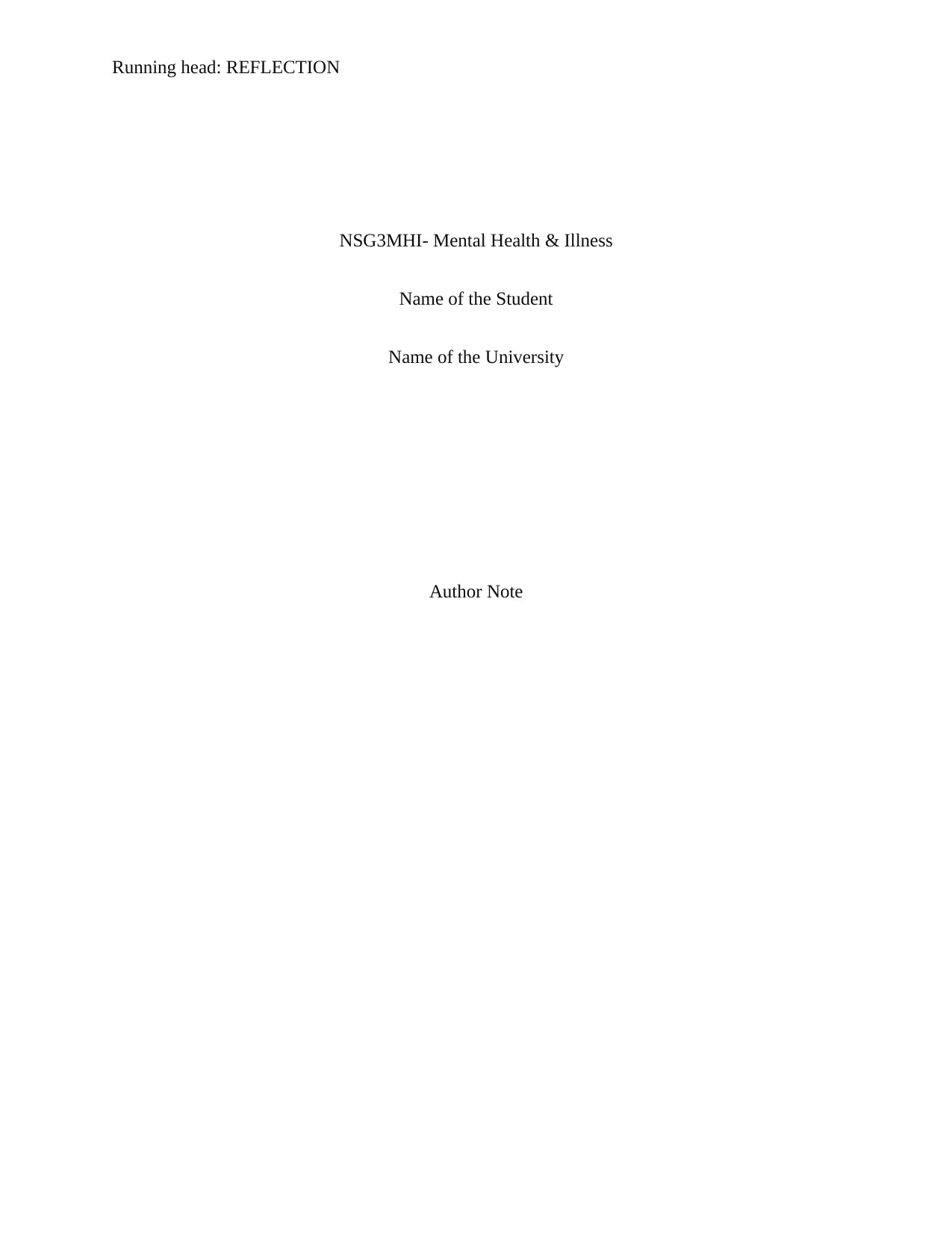
Running head: REFLECTION
NSG3MHI- Mental Health & Illness
Name of the Student
Name of the University
Author Note
NSG3MHI- Mental Health & Illness
Name of the Student
Name of the University
Author Note
Secure Best Marks with AI Grader
Need help grading? Try our AI Grader for instant feedback on your assignments.
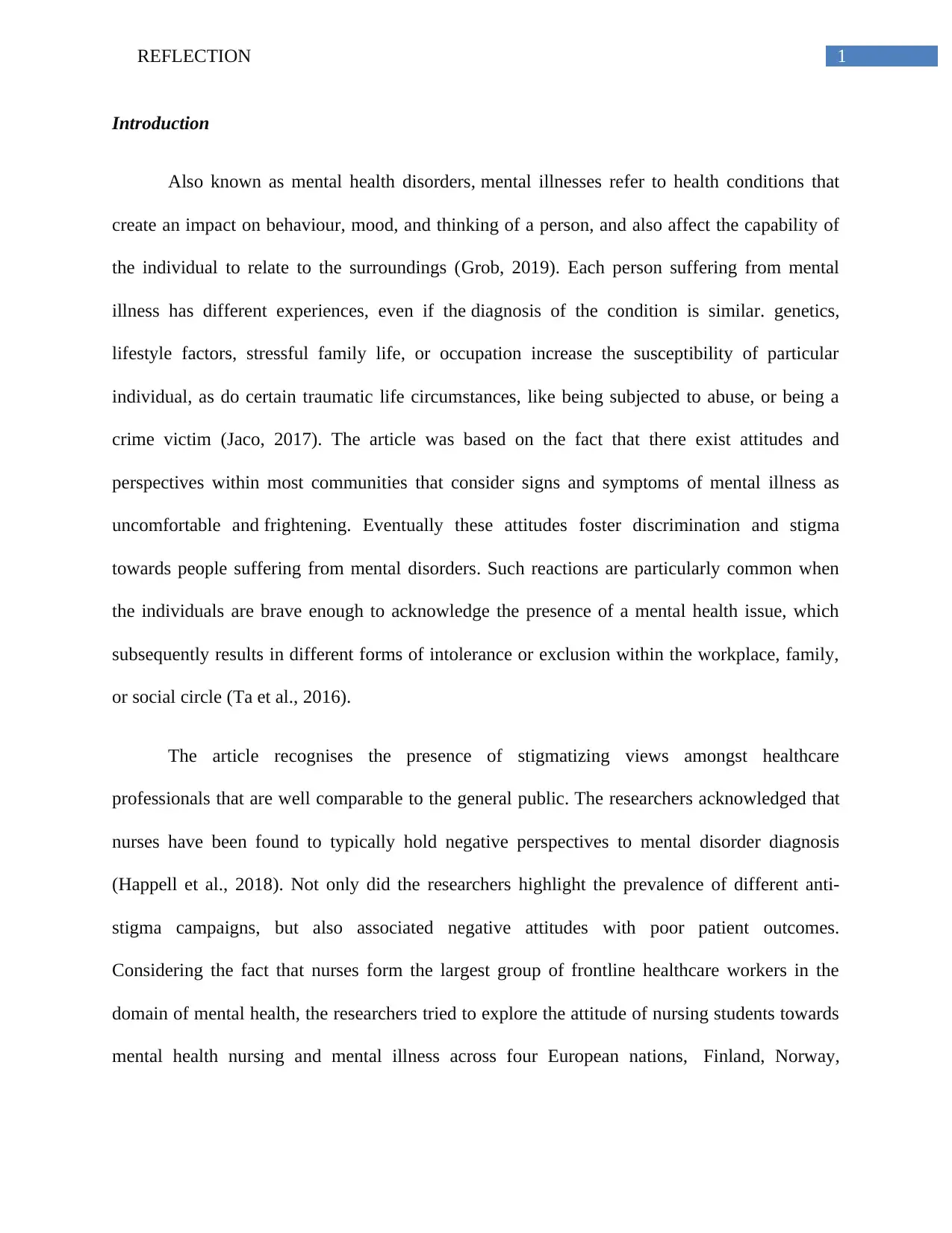
1REFLECTION
Introduction
Also known as mental health disorders, mental illnesses refer to health conditions that
create an impact on behaviour, mood, and thinking of a person, and also affect the capability of
the individual to relate to the surroundings (Grob, 2019). Each person suffering from mental
illness has different experiences, even if the diagnosis of the condition is similar. genetics,
lifestyle factors, stressful family life, or occupation increase the susceptibility of particular
individual, as do certain traumatic life circumstances, like being subjected to abuse, or being a
crime victim (Jaco, 2017). The article was based on the fact that there exist attitudes and
perspectives within most communities that consider signs and symptoms of mental illness as
uncomfortable and frightening. Eventually these attitudes foster discrimination and stigma
towards people suffering from mental disorders. Such reactions are particularly common when
the individuals are brave enough to acknowledge the presence of a mental health issue, which
subsequently results in different forms of intolerance or exclusion within the workplace, family,
or social circle (Ta et al., 2016).
The article recognises the presence of stigmatizing views amongst healthcare
professionals that are well comparable to the general public. The researchers acknowledged that
nurses have been found to typically hold negative perspectives to mental disorder diagnosis
(Happell et al., 2018). Not only did the researchers highlight the prevalence of different anti-
stigma campaigns, but also associated negative attitudes with poor patient outcomes.
Considering the fact that nurses form the largest group of frontline healthcare workers in the
domain of mental health, the researchers tried to explore the attitude of nursing students towards
mental health nursing and mental illness across four European nations, Finland, Norway,
Introduction
Also known as mental health disorders, mental illnesses refer to health conditions that
create an impact on behaviour, mood, and thinking of a person, and also affect the capability of
the individual to relate to the surroundings (Grob, 2019). Each person suffering from mental
illness has different experiences, even if the diagnosis of the condition is similar. genetics,
lifestyle factors, stressful family life, or occupation increase the susceptibility of particular
individual, as do certain traumatic life circumstances, like being subjected to abuse, or being a
crime victim (Jaco, 2017). The article was based on the fact that there exist attitudes and
perspectives within most communities that consider signs and symptoms of mental illness as
uncomfortable and frightening. Eventually these attitudes foster discrimination and stigma
towards people suffering from mental disorders. Such reactions are particularly common when
the individuals are brave enough to acknowledge the presence of a mental health issue, which
subsequently results in different forms of intolerance or exclusion within the workplace, family,
or social circle (Ta et al., 2016).
The article recognises the presence of stigmatizing views amongst healthcare
professionals that are well comparable to the general public. The researchers acknowledged that
nurses have been found to typically hold negative perspectives to mental disorder diagnosis
(Happell et al., 2018). Not only did the researchers highlight the prevalence of different anti-
stigma campaigns, but also associated negative attitudes with poor patient outcomes.
Considering the fact that nurses form the largest group of frontline healthcare workers in the
domain of mental health, the researchers tried to explore the attitude of nursing students towards
mental health nursing and mental illness across four European nations, Finland, Norway,
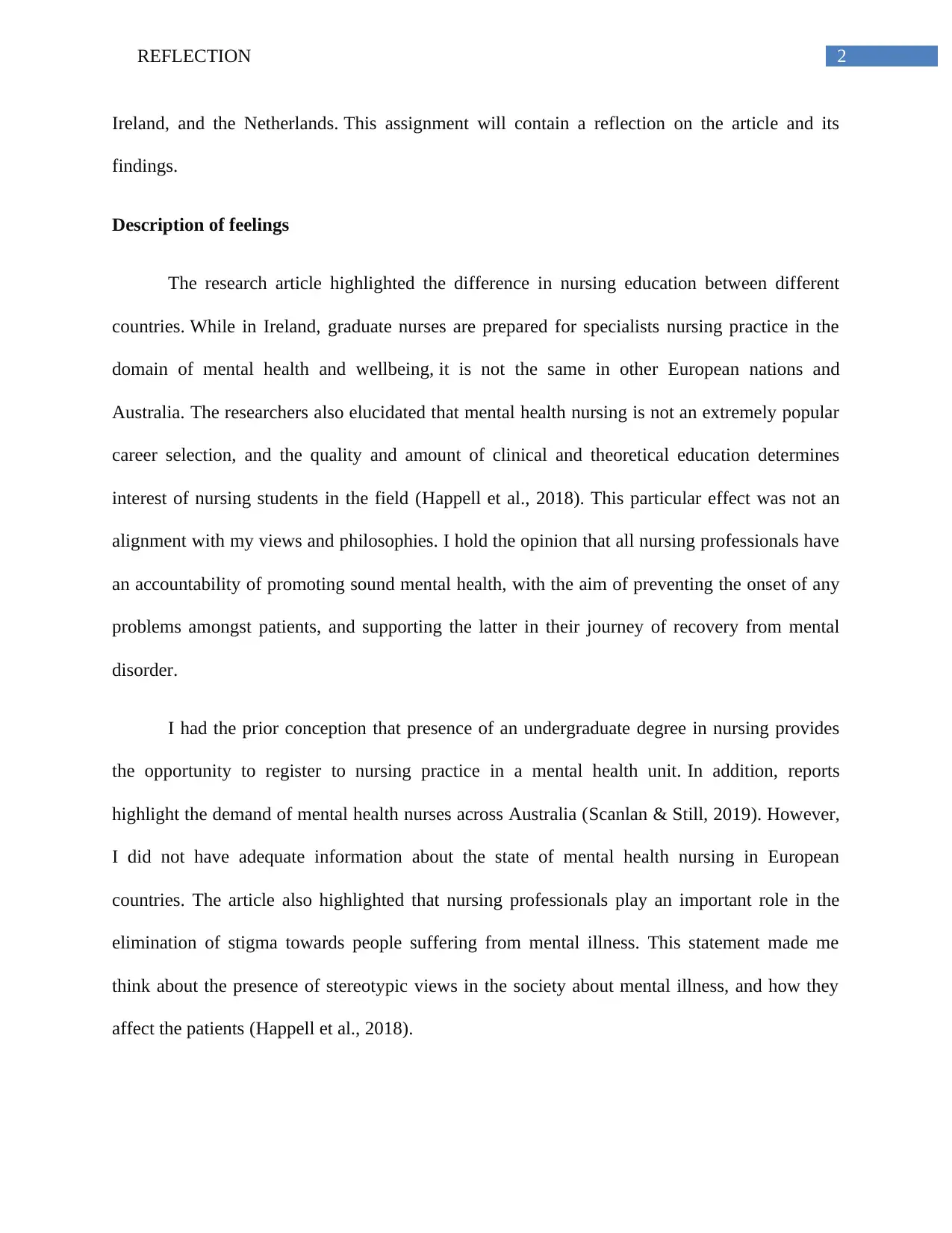
2REFLECTION
Ireland, and the Netherlands. This assignment will contain a reflection on the article and its
findings.
Description of feelings
The research article highlighted the difference in nursing education between different
countries. While in Ireland, graduate nurses are prepared for specialists nursing practice in the
domain of mental health and wellbeing, it is not the same in other European nations and
Australia. The researchers also elucidated that mental health nursing is not an extremely popular
career selection, and the quality and amount of clinical and theoretical education determines
interest of nursing students in the field (Happell et al., 2018). This particular effect was not an
alignment with my views and philosophies. I hold the opinion that all nursing professionals have
an accountability of promoting sound mental health, with the aim of preventing the onset of any
problems amongst patients, and supporting the latter in their journey of recovery from mental
disorder.
I had the prior conception that presence of an undergraduate degree in nursing provides
the opportunity to register to nursing practice in a mental health unit. In addition, reports
highlight the demand of mental health nurses across Australia (Scanlan & Still, 2019). However,
I did not have adequate information about the state of mental health nursing in European
countries. The article also highlighted that nursing professionals play an important role in the
elimination of stigma towards people suffering from mental illness. This statement made me
think about the presence of stereotypic views in the society about mental illness, and how they
affect the patients (Happell et al., 2018).
Ireland, and the Netherlands. This assignment will contain a reflection on the article and its
findings.
Description of feelings
The research article highlighted the difference in nursing education between different
countries. While in Ireland, graduate nurses are prepared for specialists nursing practice in the
domain of mental health and wellbeing, it is not the same in other European nations and
Australia. The researchers also elucidated that mental health nursing is not an extremely popular
career selection, and the quality and amount of clinical and theoretical education determines
interest of nursing students in the field (Happell et al., 2018). This particular effect was not an
alignment with my views and philosophies. I hold the opinion that all nursing professionals have
an accountability of promoting sound mental health, with the aim of preventing the onset of any
problems amongst patients, and supporting the latter in their journey of recovery from mental
disorder.
I had the prior conception that presence of an undergraduate degree in nursing provides
the opportunity to register to nursing practice in a mental health unit. In addition, reports
highlight the demand of mental health nurses across Australia (Scanlan & Still, 2019). However,
I did not have adequate information about the state of mental health nursing in European
countries. The article also highlighted that nursing professionals play an important role in the
elimination of stigma towards people suffering from mental illness. This statement made me
think about the presence of stereotypic views in the society about mental illness, and how they
affect the patients (Happell et al., 2018).
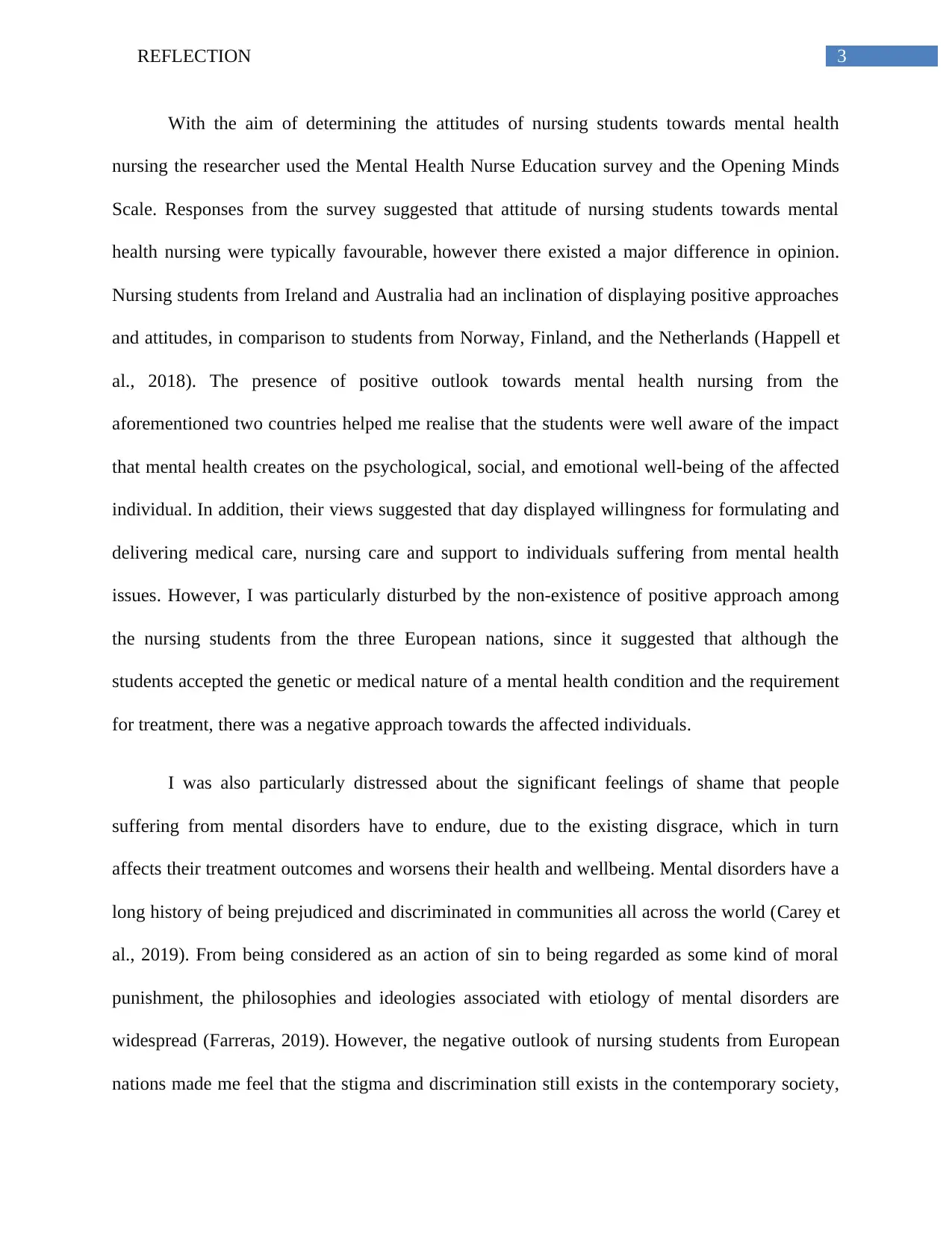
3REFLECTION
With the aim of determining the attitudes of nursing students towards mental health
nursing the researcher used the Mental Health Nurse Education survey and the Opening Minds
Scale. Responses from the survey suggested that attitude of nursing students towards mental
health nursing were typically favourable, however there existed a major difference in opinion.
Nursing students from Ireland and Australia had an inclination of displaying positive approaches
and attitudes, in comparison to students from Norway, Finland, and the Netherlands (Happell et
al., 2018). The presence of positive outlook towards mental health nursing from the
aforementioned two countries helped me realise that the students were well aware of the impact
that mental health creates on the psychological, social, and emotional well-being of the affected
individual. In addition, their views suggested that day displayed willingness for formulating and
delivering medical care, nursing care and support to individuals suffering from mental health
issues. However, I was particularly disturbed by the non-existence of positive approach among
the nursing students from the three European nations, since it suggested that although the
students accepted the genetic or medical nature of a mental health condition and the requirement
for treatment, there was a negative approach towards the affected individuals.
I was also particularly distressed about the significant feelings of shame that people
suffering from mental disorders have to endure, due to the existing disgrace, which in turn
affects their treatment outcomes and worsens their health and wellbeing. Mental disorders have a
long history of being prejudiced and discriminated in communities all across the world (Carey et
al., 2019). From being considered as an action of sin to being regarded as some kind of moral
punishment, the philosophies and ideologies associated with etiology of mental disorders are
widespread (Farreras, 2019). However, the negative outlook of nursing students from European
nations made me feel that the stigma and discrimination still exists in the contemporary society,
With the aim of determining the attitudes of nursing students towards mental health
nursing the researcher used the Mental Health Nurse Education survey and the Opening Minds
Scale. Responses from the survey suggested that attitude of nursing students towards mental
health nursing were typically favourable, however there existed a major difference in opinion.
Nursing students from Ireland and Australia had an inclination of displaying positive approaches
and attitudes, in comparison to students from Norway, Finland, and the Netherlands (Happell et
al., 2018). The presence of positive outlook towards mental health nursing from the
aforementioned two countries helped me realise that the students were well aware of the impact
that mental health creates on the psychological, social, and emotional well-being of the affected
individual. In addition, their views suggested that day displayed willingness for formulating and
delivering medical care, nursing care and support to individuals suffering from mental health
issues. However, I was particularly disturbed by the non-existence of positive approach among
the nursing students from the three European nations, since it suggested that although the
students accepted the genetic or medical nature of a mental health condition and the requirement
for treatment, there was a negative approach towards the affected individuals.
I was also particularly distressed about the significant feelings of shame that people
suffering from mental disorders have to endure, due to the existing disgrace, which in turn
affects their treatment outcomes and worsens their health and wellbeing. Mental disorders have a
long history of being prejudiced and discriminated in communities all across the world (Carey et
al., 2019). From being considered as an action of sin to being regarded as some kind of moral
punishment, the philosophies and ideologies associated with etiology of mental disorders are
widespread (Farreras, 2019). However, the negative outlook of nursing students from European
nations made me feel that the stigma and discrimination still exists in the contemporary society,
Secure Best Marks with AI Grader
Need help grading? Try our AI Grader for instant feedback on your assignments.
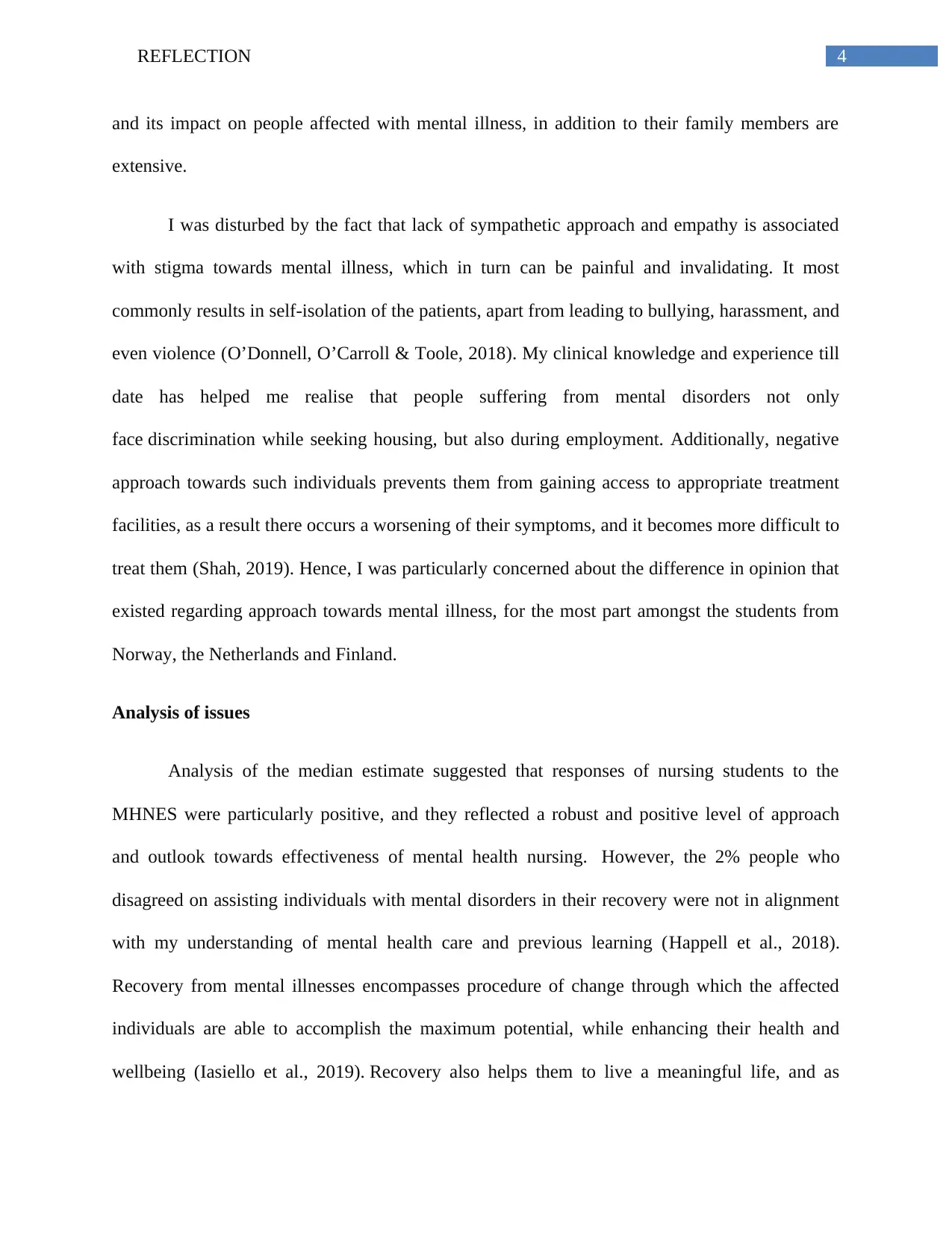
4REFLECTION
and its impact on people affected with mental illness, in addition to their family members are
extensive.
I was disturbed by the fact that lack of sympathetic approach and empathy is associated
with stigma towards mental illness, which in turn can be painful and invalidating. It most
commonly results in self-isolation of the patients, apart from leading to bullying, harassment, and
even violence (O’Donnell, O’Carroll & Toole, 2018). My clinical knowledge and experience till
date has helped me realise that people suffering from mental disorders not only
face discrimination while seeking housing, but also during employment. Additionally, negative
approach towards such individuals prevents them from gaining access to appropriate treatment
facilities, as a result there occurs a worsening of their symptoms, and it becomes more difficult to
treat them (Shah, 2019). Hence, I was particularly concerned about the difference in opinion that
existed regarding approach towards mental illness, for the most part amongst the students from
Norway, the Netherlands and Finland.
Analysis of issues
Analysis of the median estimate suggested that responses of nursing students to the
MHNES were particularly positive, and they reflected a robust and positive level of approach
and outlook towards effectiveness of mental health nursing. However, the 2% people who
disagreed on assisting individuals with mental disorders in their recovery were not in alignment
with my understanding of mental health care and previous learning (Happell et al., 2018).
Recovery from mental illnesses encompasses procedure of change through which the affected
individuals are able to accomplish the maximum potential, while enhancing their health and
wellbeing (Iasiello et al., 2019). Recovery also helps them to live a meaningful life, and as
and its impact on people affected with mental illness, in addition to their family members are
extensive.
I was disturbed by the fact that lack of sympathetic approach and empathy is associated
with stigma towards mental illness, which in turn can be painful and invalidating. It most
commonly results in self-isolation of the patients, apart from leading to bullying, harassment, and
even violence (O’Donnell, O’Carroll & Toole, 2018). My clinical knowledge and experience till
date has helped me realise that people suffering from mental disorders not only
face discrimination while seeking housing, but also during employment. Additionally, negative
approach towards such individuals prevents them from gaining access to appropriate treatment
facilities, as a result there occurs a worsening of their symptoms, and it becomes more difficult to
treat them (Shah, 2019). Hence, I was particularly concerned about the difference in opinion that
existed regarding approach towards mental illness, for the most part amongst the students from
Norway, the Netherlands and Finland.
Analysis of issues
Analysis of the median estimate suggested that responses of nursing students to the
MHNES were particularly positive, and they reflected a robust and positive level of approach
and outlook towards effectiveness of mental health nursing. However, the 2% people who
disagreed on assisting individuals with mental disorders in their recovery were not in alignment
with my understanding of mental health care and previous learning (Happell et al., 2018).
Recovery from mental illnesses encompasses procedure of change through which the affected
individuals are able to accomplish the maximum potential, while enhancing their health and
wellbeing (Iasiello et al., 2019). Recovery also helps them to live a meaningful life, and as
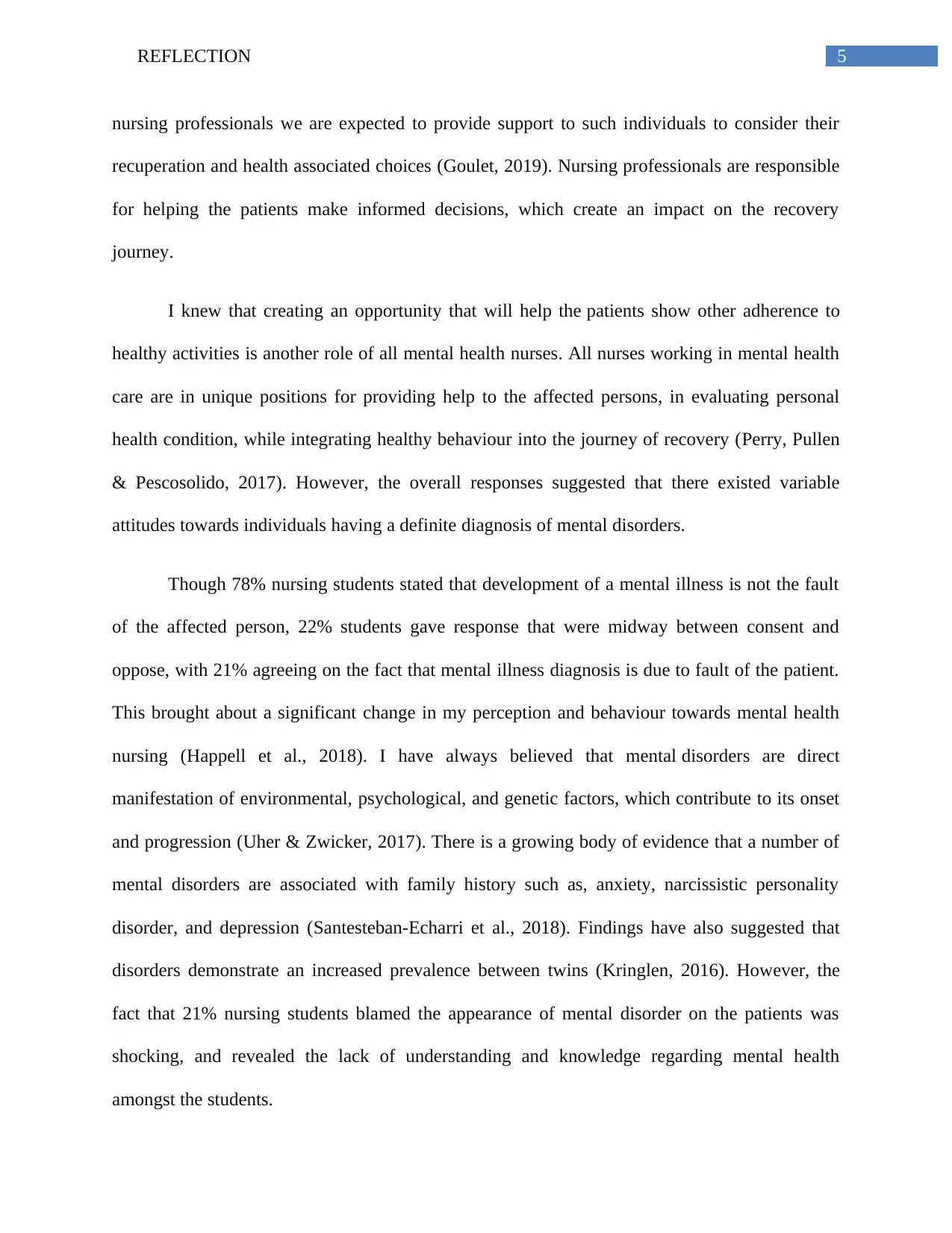
5REFLECTION
nursing professionals we are expected to provide support to such individuals to consider their
recuperation and health associated choices (Goulet, 2019). Nursing professionals are responsible
for helping the patients make informed decisions, which create an impact on the recovery
journey.
I knew that creating an opportunity that will help the patients show other adherence to
healthy activities is another role of all mental health nurses. All nurses working in mental health
care are in unique positions for providing help to the affected persons, in evaluating personal
health condition, while integrating healthy behaviour into the journey of recovery (Perry, Pullen
& Pescosolido, 2017). However, the overall responses suggested that there existed variable
attitudes towards individuals having a definite diagnosis of mental disorders.
Though 78% nursing students stated that development of a mental illness is not the fault
of the affected person, 22% students gave response that were midway between consent and
oppose, with 21% agreeing on the fact that mental illness diagnosis is due to fault of the patient.
This brought about a significant change in my perception and behaviour towards mental health
nursing (Happell et al., 2018). I have always believed that mental disorders are direct
manifestation of environmental, psychological, and genetic factors, which contribute to its onset
and progression (Uher & Zwicker, 2017). There is a growing body of evidence that a number of
mental disorders are associated with family history such as, anxiety, narcissistic personality
disorder, and depression (Santesteban-Echarri et al., 2018). Findings have also suggested that
disorders demonstrate an increased prevalence between twins (Kringlen, 2016). However, the
fact that 21% nursing students blamed the appearance of mental disorder on the patients was
shocking, and revealed the lack of understanding and knowledge regarding mental health
amongst the students.
nursing professionals we are expected to provide support to such individuals to consider their
recuperation and health associated choices (Goulet, 2019). Nursing professionals are responsible
for helping the patients make informed decisions, which create an impact on the recovery
journey.
I knew that creating an opportunity that will help the patients show other adherence to
healthy activities is another role of all mental health nurses. All nurses working in mental health
care are in unique positions for providing help to the affected persons, in evaluating personal
health condition, while integrating healthy behaviour into the journey of recovery (Perry, Pullen
& Pescosolido, 2017). However, the overall responses suggested that there existed variable
attitudes towards individuals having a definite diagnosis of mental disorders.
Though 78% nursing students stated that development of a mental illness is not the fault
of the affected person, 22% students gave response that were midway between consent and
oppose, with 21% agreeing on the fact that mental illness diagnosis is due to fault of the patient.
This brought about a significant change in my perception and behaviour towards mental health
nursing (Happell et al., 2018). I have always believed that mental disorders are direct
manifestation of environmental, psychological, and genetic factors, which contribute to its onset
and progression (Uher & Zwicker, 2017). There is a growing body of evidence that a number of
mental disorders are associated with family history such as, anxiety, narcissistic personality
disorder, and depression (Santesteban-Echarri et al., 2018). Findings have also suggested that
disorders demonstrate an increased prevalence between twins (Kringlen, 2016). However, the
fact that 21% nursing students blamed the appearance of mental disorder on the patients was
shocking, and revealed the lack of understanding and knowledge regarding mental health
amongst the students.
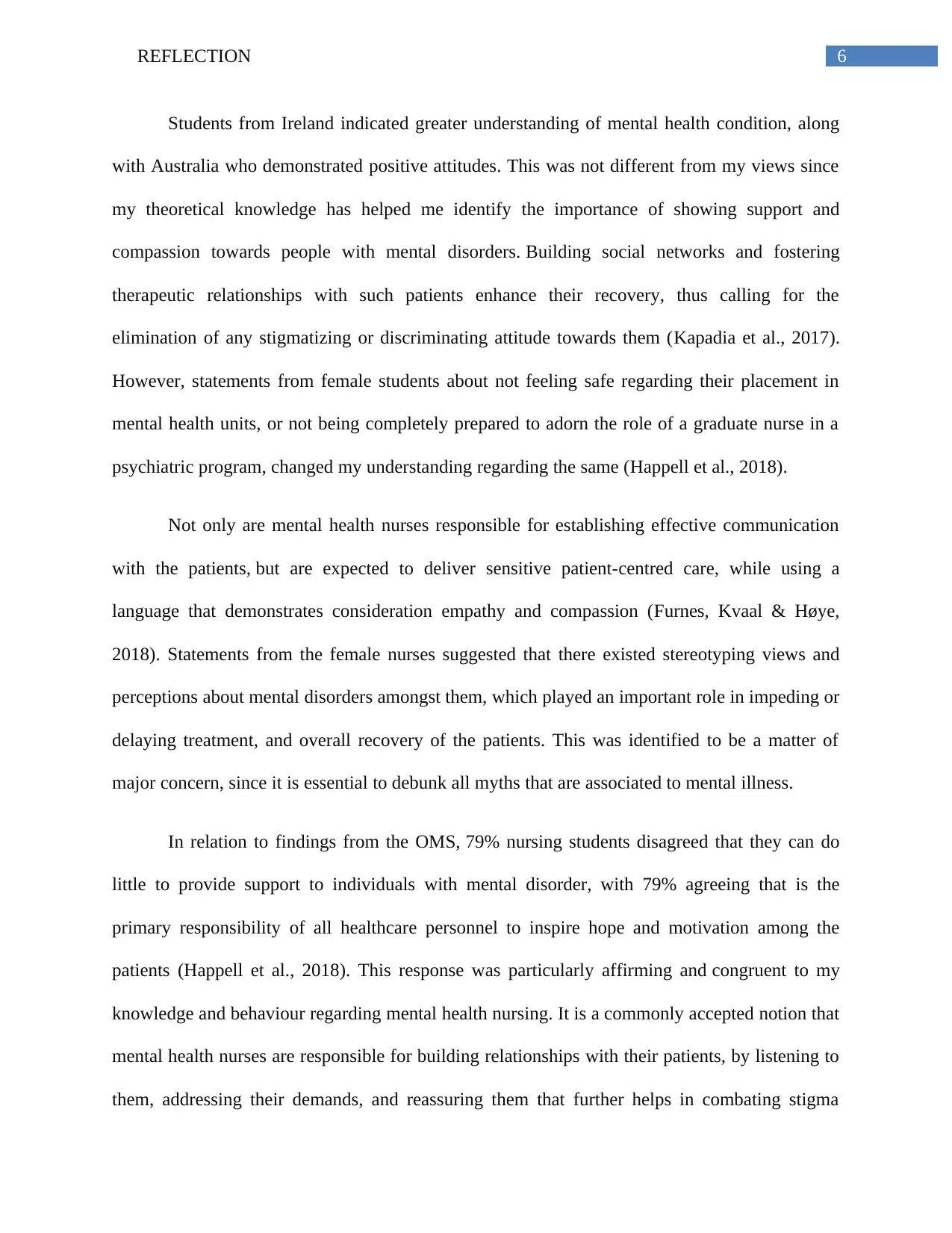
6REFLECTION
Students from Ireland indicated greater understanding of mental health condition, along
with Australia who demonstrated positive attitudes. This was not different from my views since
my theoretical knowledge has helped me identify the importance of showing support and
compassion towards people with mental disorders. Building social networks and fostering
therapeutic relationships with such patients enhance their recovery, thus calling for the
elimination of any stigmatizing or discriminating attitude towards them (Kapadia et al., 2017).
However, statements from female students about not feeling safe regarding their placement in
mental health units, or not being completely prepared to adorn the role of a graduate nurse in a
psychiatric program, changed my understanding regarding the same (Happell et al., 2018).
Not only are mental health nurses responsible for establishing effective communication
with the patients, but are expected to deliver sensitive patient-centred care, while using a
language that demonstrates consideration empathy and compassion (Furnes, Kvaal & Høye,
2018). Statements from the female nurses suggested that there existed stereotyping views and
perceptions about mental disorders amongst them, which played an important role in impeding or
delaying treatment, and overall recovery of the patients. This was identified to be a matter of
major concern, since it is essential to debunk all myths that are associated to mental illness.
In relation to findings from the OMS, 79% nursing students disagreed that they can do
little to provide support to individuals with mental disorder, with 79% agreeing that is the
primary responsibility of all healthcare personnel to inspire hope and motivation among the
patients (Happell et al., 2018). This response was particularly affirming and congruent to my
knowledge and behaviour regarding mental health nursing. It is a commonly accepted notion that
mental health nurses are responsible for building relationships with their patients, by listening to
them, addressing their demands, and reassuring them that further helps in combating stigma
Students from Ireland indicated greater understanding of mental health condition, along
with Australia who demonstrated positive attitudes. This was not different from my views since
my theoretical knowledge has helped me identify the importance of showing support and
compassion towards people with mental disorders. Building social networks and fostering
therapeutic relationships with such patients enhance their recovery, thus calling for the
elimination of any stigmatizing or discriminating attitude towards them (Kapadia et al., 2017).
However, statements from female students about not feeling safe regarding their placement in
mental health units, or not being completely prepared to adorn the role of a graduate nurse in a
psychiatric program, changed my understanding regarding the same (Happell et al., 2018).
Not only are mental health nurses responsible for establishing effective communication
with the patients, but are expected to deliver sensitive patient-centred care, while using a
language that demonstrates consideration empathy and compassion (Furnes, Kvaal & Høye,
2018). Statements from the female nurses suggested that there existed stereotyping views and
perceptions about mental disorders amongst them, which played an important role in impeding or
delaying treatment, and overall recovery of the patients. This was identified to be a matter of
major concern, since it is essential to debunk all myths that are associated to mental illness.
In relation to findings from the OMS, 79% nursing students disagreed that they can do
little to provide support to individuals with mental disorder, with 79% agreeing that is the
primary responsibility of all healthcare personnel to inspire hope and motivation among the
patients (Happell et al., 2018). This response was particularly affirming and congruent to my
knowledge and behaviour regarding mental health nursing. It is a commonly accepted notion that
mental health nurses are responsible for building relationships with their patients, by listening to
them, addressing their demands, and reassuring them that further helps in combating stigma
Paraphrase This Document
Need a fresh take? Get an instant paraphrase of this document with our AI Paraphraser
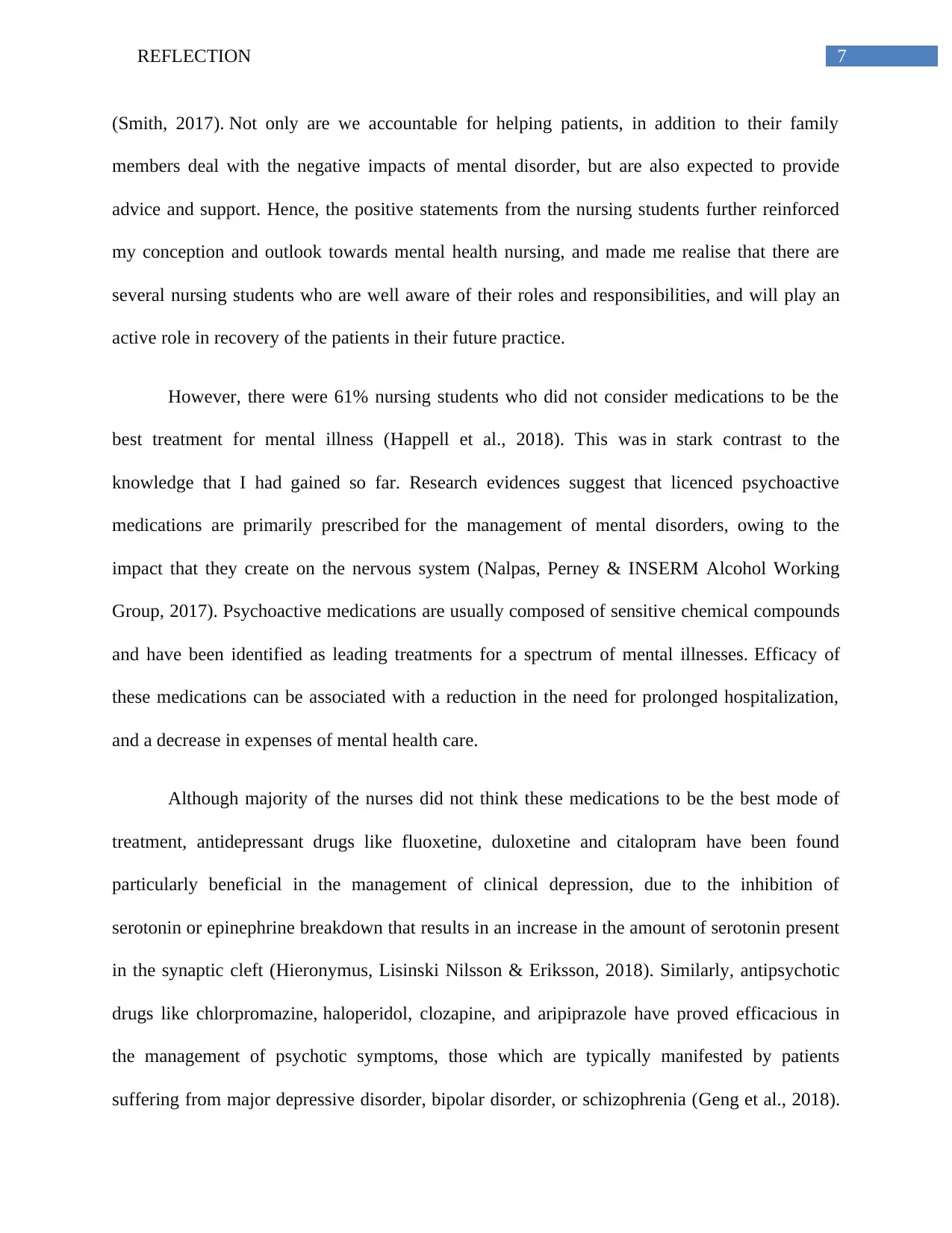
7REFLECTION
(Smith, 2017). Not only are we accountable for helping patients, in addition to their family
members deal with the negative impacts of mental disorder, but are also expected to provide
advice and support. Hence, the positive statements from the nursing students further reinforced
my conception and outlook towards mental health nursing, and made me realise that there are
several nursing students who are well aware of their roles and responsibilities, and will play an
active role in recovery of the patients in their future practice.
However, there were 61% nursing students who did not consider medications to be the
best treatment for mental illness (Happell et al., 2018). This was in stark contrast to the
knowledge that I had gained so far. Research evidences suggest that licenced psychoactive
medications are primarily prescribed for the management of mental disorders, owing to the
impact that they create on the nervous system (Nalpas, Perney & INSERM Alcohol Working
Group, 2017). Psychoactive medications are usually composed of sensitive chemical compounds
and have been identified as leading treatments for a spectrum of mental illnesses. Efficacy of
these medications can be associated with a reduction in the need for prolonged hospitalization,
and a decrease in expenses of mental health care.
Although majority of the nurses did not think these medications to be the best mode of
treatment, antidepressant drugs like fluoxetine, duloxetine and citalopram have been found
particularly beneficial in the management of clinical depression, due to the inhibition of
serotonin or epinephrine breakdown that results in an increase in the amount of serotonin present
in the synaptic cleft (Hieronymus, Lisinski Nilsson & Eriksson, 2018). Similarly, antipsychotic
drugs like chlorpromazine, haloperidol, clozapine, and aripiprazole have proved efficacious in
the management of psychotic symptoms, those which are typically manifested by patients
suffering from major depressive disorder, bipolar disorder, or schizophrenia (Geng et al., 2018).
(Smith, 2017). Not only are we accountable for helping patients, in addition to their family
members deal with the negative impacts of mental disorder, but are also expected to provide
advice and support. Hence, the positive statements from the nursing students further reinforced
my conception and outlook towards mental health nursing, and made me realise that there are
several nursing students who are well aware of their roles and responsibilities, and will play an
active role in recovery of the patients in their future practice.
However, there were 61% nursing students who did not consider medications to be the
best treatment for mental illness (Happell et al., 2018). This was in stark contrast to the
knowledge that I had gained so far. Research evidences suggest that licenced psychoactive
medications are primarily prescribed for the management of mental disorders, owing to the
impact that they create on the nervous system (Nalpas, Perney & INSERM Alcohol Working
Group, 2017). Psychoactive medications are usually composed of sensitive chemical compounds
and have been identified as leading treatments for a spectrum of mental illnesses. Efficacy of
these medications can be associated with a reduction in the need for prolonged hospitalization,
and a decrease in expenses of mental health care.
Although majority of the nurses did not think these medications to be the best mode of
treatment, antidepressant drugs like fluoxetine, duloxetine and citalopram have been found
particularly beneficial in the management of clinical depression, due to the inhibition of
serotonin or epinephrine breakdown that results in an increase in the amount of serotonin present
in the synaptic cleft (Hieronymus, Lisinski Nilsson & Eriksson, 2018). Similarly, antipsychotic
drugs like chlorpromazine, haloperidol, clozapine, and aripiprazole have proved efficacious in
the management of psychotic symptoms, those which are typically manifested by patients
suffering from major depressive disorder, bipolar disorder, or schizophrenia (Geng et al., 2018).
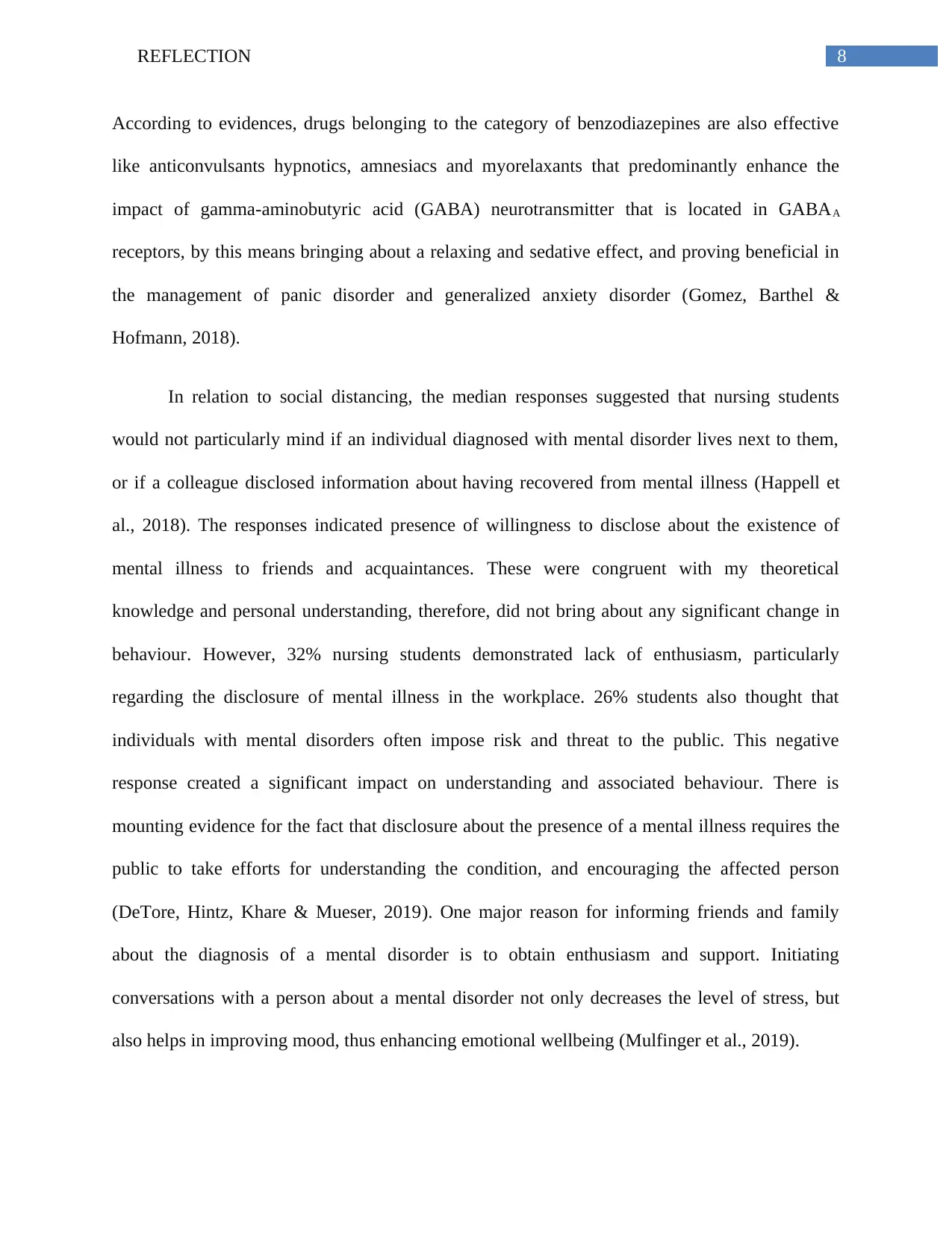
8REFLECTION
According to evidences, drugs belonging to the category of benzodiazepines are also effective
like anticonvulsants hypnotics, amnesiacs and myorelaxants that predominantly enhance the
impact of gamma-aminobutyric acid (GABA) neurotransmitter that is located in GABAA
receptors, by this means bringing about a relaxing and sedative effect, and proving beneficial in
the management of panic disorder and generalized anxiety disorder (Gomez, Barthel &
Hofmann, 2018).
In relation to social distancing, the median responses suggested that nursing students
would not particularly mind if an individual diagnosed with mental disorder lives next to them,
or if a colleague disclosed information about having recovered from mental illness (Happell et
al., 2018). The responses indicated presence of willingness to disclose about the existence of
mental illness to friends and acquaintances. These were congruent with my theoretical
knowledge and personal understanding, therefore, did not bring about any significant change in
behaviour. However, 32% nursing students demonstrated lack of enthusiasm, particularly
regarding the disclosure of mental illness in the workplace. 26% students also thought that
individuals with mental disorders often impose risk and threat to the public. This negative
response created a significant impact on understanding and associated behaviour. There is
mounting evidence for the fact that disclosure about the presence of a mental illness requires the
public to take efforts for understanding the condition, and encouraging the affected person
(DeTore, Hintz, Khare & Mueser, 2019). One major reason for informing friends and family
about the diagnosis of a mental disorder is to obtain enthusiasm and support. Initiating
conversations with a person about a mental disorder not only decreases the level of stress, but
also helps in improving mood, thus enhancing emotional wellbeing (Mulfinger et al., 2019).
According to evidences, drugs belonging to the category of benzodiazepines are also effective
like anticonvulsants hypnotics, amnesiacs and myorelaxants that predominantly enhance the
impact of gamma-aminobutyric acid (GABA) neurotransmitter that is located in GABAA
receptors, by this means bringing about a relaxing and sedative effect, and proving beneficial in
the management of panic disorder and generalized anxiety disorder (Gomez, Barthel &
Hofmann, 2018).
In relation to social distancing, the median responses suggested that nursing students
would not particularly mind if an individual diagnosed with mental disorder lives next to them,
or if a colleague disclosed information about having recovered from mental illness (Happell et
al., 2018). The responses indicated presence of willingness to disclose about the existence of
mental illness to friends and acquaintances. These were congruent with my theoretical
knowledge and personal understanding, therefore, did not bring about any significant change in
behaviour. However, 32% nursing students demonstrated lack of enthusiasm, particularly
regarding the disclosure of mental illness in the workplace. 26% students also thought that
individuals with mental disorders often impose risk and threat to the public. This negative
response created a significant impact on understanding and associated behaviour. There is
mounting evidence for the fact that disclosure about the presence of a mental illness requires the
public to take efforts for understanding the condition, and encouraging the affected person
(DeTore, Hintz, Khare & Mueser, 2019). One major reason for informing friends and family
about the diagnosis of a mental disorder is to obtain enthusiasm and support. Initiating
conversations with a person about a mental disorder not only decreases the level of stress, but
also helps in improving mood, thus enhancing emotional wellbeing (Mulfinger et al., 2019).
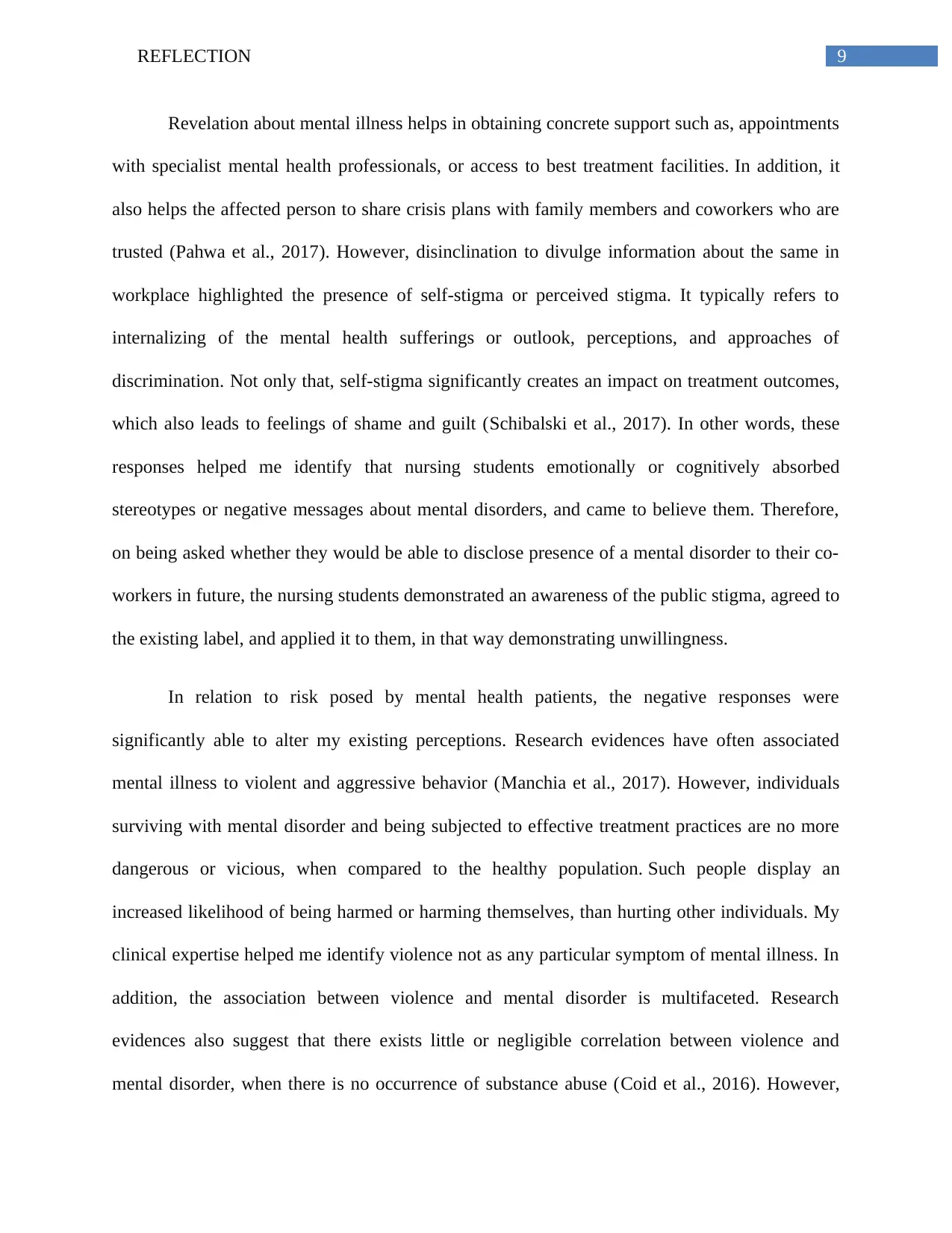
9REFLECTION
Revelation about mental illness helps in obtaining concrete support such as, appointments
with specialist mental health professionals, or access to best treatment facilities. In addition, it
also helps the affected person to share crisis plans with family members and coworkers who are
trusted (Pahwa et al., 2017). However, disinclination to divulge information about the same in
workplace highlighted the presence of self-stigma or perceived stigma. It typically refers to
internalizing of the mental health sufferings or outlook, perceptions, and approaches of
discrimination. Not only that, self-stigma significantly creates an impact on treatment outcomes,
which also leads to feelings of shame and guilt (Schibalski et al., 2017). In other words, these
responses helped me identify that nursing students emotionally or cognitively absorbed
stereotypes or negative messages about mental disorders, and came to believe them. Therefore,
on being asked whether they would be able to disclose presence of a mental disorder to their co-
workers in future, the nursing students demonstrated an awareness of the public stigma, agreed to
the existing label, and applied it to them, in that way demonstrating unwillingness.
In relation to risk posed by mental health patients, the negative responses were
significantly able to alter my existing perceptions. Research evidences have often associated
mental illness to violent and aggressive behavior (Manchia et al., 2017). However, individuals
surviving with mental disorder and being subjected to effective treatment practices are no more
dangerous or vicious, when compared to the healthy population. Such people display an
increased likelihood of being harmed or harming themselves, than hurting other individuals. My
clinical expertise helped me identify violence not as any particular symptom of mental illness. In
addition, the association between violence and mental disorder is multifaceted. Research
evidences also suggest that there exists little or negligible correlation between violence and
mental disorder, when there is no occurrence of substance abuse (Coid et al., 2016). However,
Revelation about mental illness helps in obtaining concrete support such as, appointments
with specialist mental health professionals, or access to best treatment facilities. In addition, it
also helps the affected person to share crisis plans with family members and coworkers who are
trusted (Pahwa et al., 2017). However, disinclination to divulge information about the same in
workplace highlighted the presence of self-stigma or perceived stigma. It typically refers to
internalizing of the mental health sufferings or outlook, perceptions, and approaches of
discrimination. Not only that, self-stigma significantly creates an impact on treatment outcomes,
which also leads to feelings of shame and guilt (Schibalski et al., 2017). In other words, these
responses helped me identify that nursing students emotionally or cognitively absorbed
stereotypes or negative messages about mental disorders, and came to believe them. Therefore,
on being asked whether they would be able to disclose presence of a mental disorder to their co-
workers in future, the nursing students demonstrated an awareness of the public stigma, agreed to
the existing label, and applied it to them, in that way demonstrating unwillingness.
In relation to risk posed by mental health patients, the negative responses were
significantly able to alter my existing perceptions. Research evidences have often associated
mental illness to violent and aggressive behavior (Manchia et al., 2017). However, individuals
surviving with mental disorder and being subjected to effective treatment practices are no more
dangerous or vicious, when compared to the healthy population. Such people display an
increased likelihood of being harmed or harming themselves, than hurting other individuals. My
clinical expertise helped me identify violence not as any particular symptom of mental illness. In
addition, the association between violence and mental disorder is multifaceted. Research
evidences also suggest that there exists little or negligible correlation between violence and
mental disorder, when there is no occurrence of substance abuse (Coid et al., 2016). However,
Secure Best Marks with AI Grader
Need help grading? Try our AI Grader for instant feedback on your assignments.
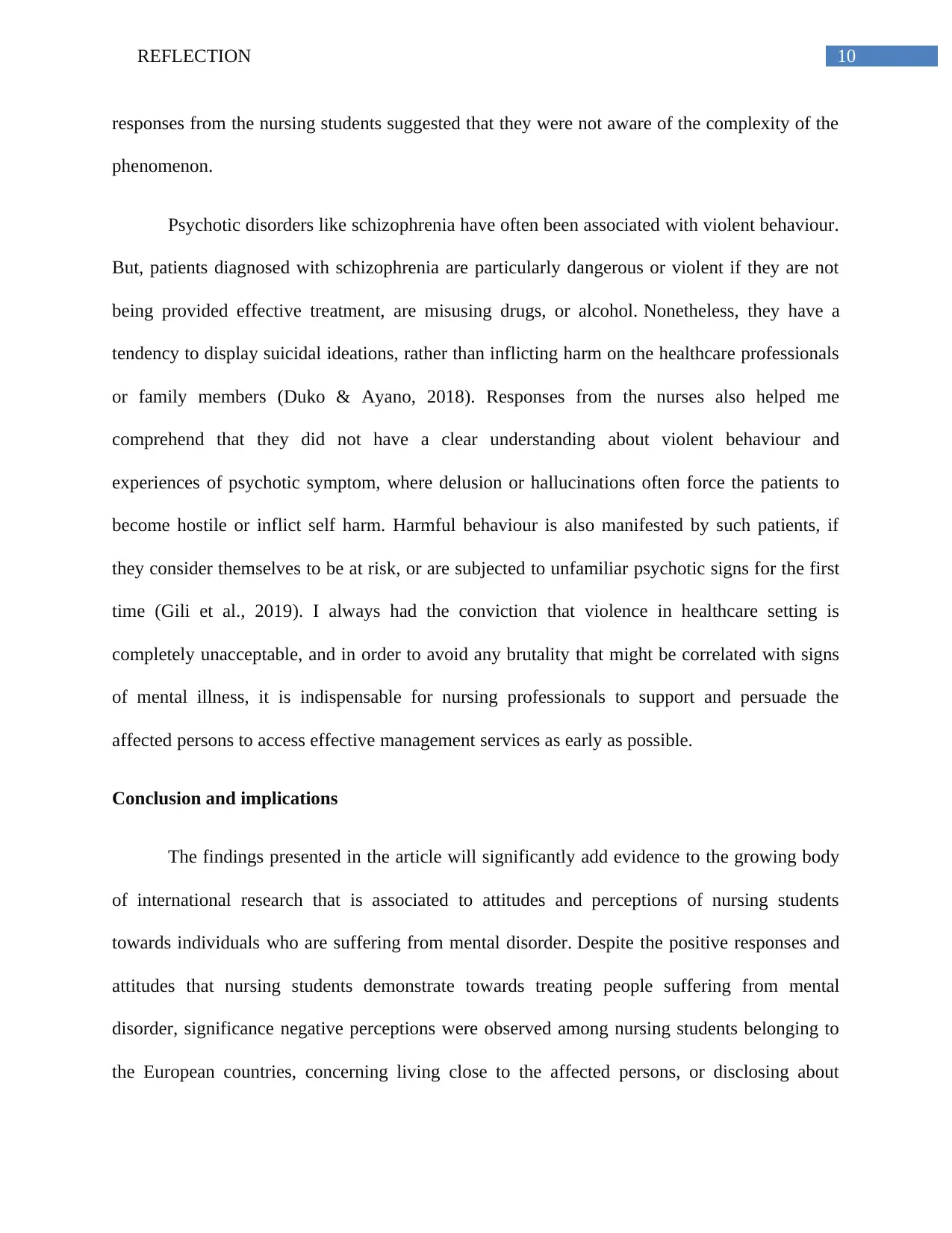
10REFLECTION
responses from the nursing students suggested that they were not aware of the complexity of the
phenomenon.
Psychotic disorders like schizophrenia have often been associated with violent behaviour.
But, patients diagnosed with schizophrenia are particularly dangerous or violent if they are not
being provided effective treatment, are misusing drugs, or alcohol. Nonetheless, they have a
tendency to display suicidal ideations, rather than inflicting harm on the healthcare professionals
or family members (Duko & Ayano, 2018). Responses from the nurses also helped me
comprehend that they did not have a clear understanding about violent behaviour and
experiences of psychotic symptom, where delusion or hallucinations often force the patients to
become hostile or inflict self harm. Harmful behaviour is also manifested by such patients, if
they consider themselves to be at risk, or are subjected to unfamiliar psychotic signs for the first
time (Gili et al., 2019). I always had the conviction that violence in healthcare setting is
completely unacceptable, and in order to avoid any brutality that might be correlated with signs
of mental illness, it is indispensable for nursing professionals to support and persuade the
affected persons to access effective management services as early as possible.
Conclusion and implications
The findings presented in the article will significantly add evidence to the growing body
of international research that is associated to attitudes and perceptions of nursing students
towards individuals who are suffering from mental disorder. Despite the positive responses and
attitudes that nursing students demonstrate towards treating people suffering from mental
disorder, significance negative perceptions were observed among nursing students belonging to
the European countries, concerning living close to the affected persons, or disclosing about
responses from the nursing students suggested that they were not aware of the complexity of the
phenomenon.
Psychotic disorders like schizophrenia have often been associated with violent behaviour.
But, patients diagnosed with schizophrenia are particularly dangerous or violent if they are not
being provided effective treatment, are misusing drugs, or alcohol. Nonetheless, they have a
tendency to display suicidal ideations, rather than inflicting harm on the healthcare professionals
or family members (Duko & Ayano, 2018). Responses from the nurses also helped me
comprehend that they did not have a clear understanding about violent behaviour and
experiences of psychotic symptom, where delusion or hallucinations often force the patients to
become hostile or inflict self harm. Harmful behaviour is also manifested by such patients, if
they consider themselves to be at risk, or are subjected to unfamiliar psychotic signs for the first
time (Gili et al., 2019). I always had the conviction that violence in healthcare setting is
completely unacceptable, and in order to avoid any brutality that might be correlated with signs
of mental illness, it is indispensable for nursing professionals to support and persuade the
affected persons to access effective management services as early as possible.
Conclusion and implications
The findings presented in the article will significantly add evidence to the growing body
of international research that is associated to attitudes and perceptions of nursing students
towards individuals who are suffering from mental disorder. Despite the positive responses and
attitudes that nursing students demonstrate towards treating people suffering from mental
disorder, significance negative perceptions were observed among nursing students belonging to
the European countries, concerning living close to the affected persons, or disclosing about
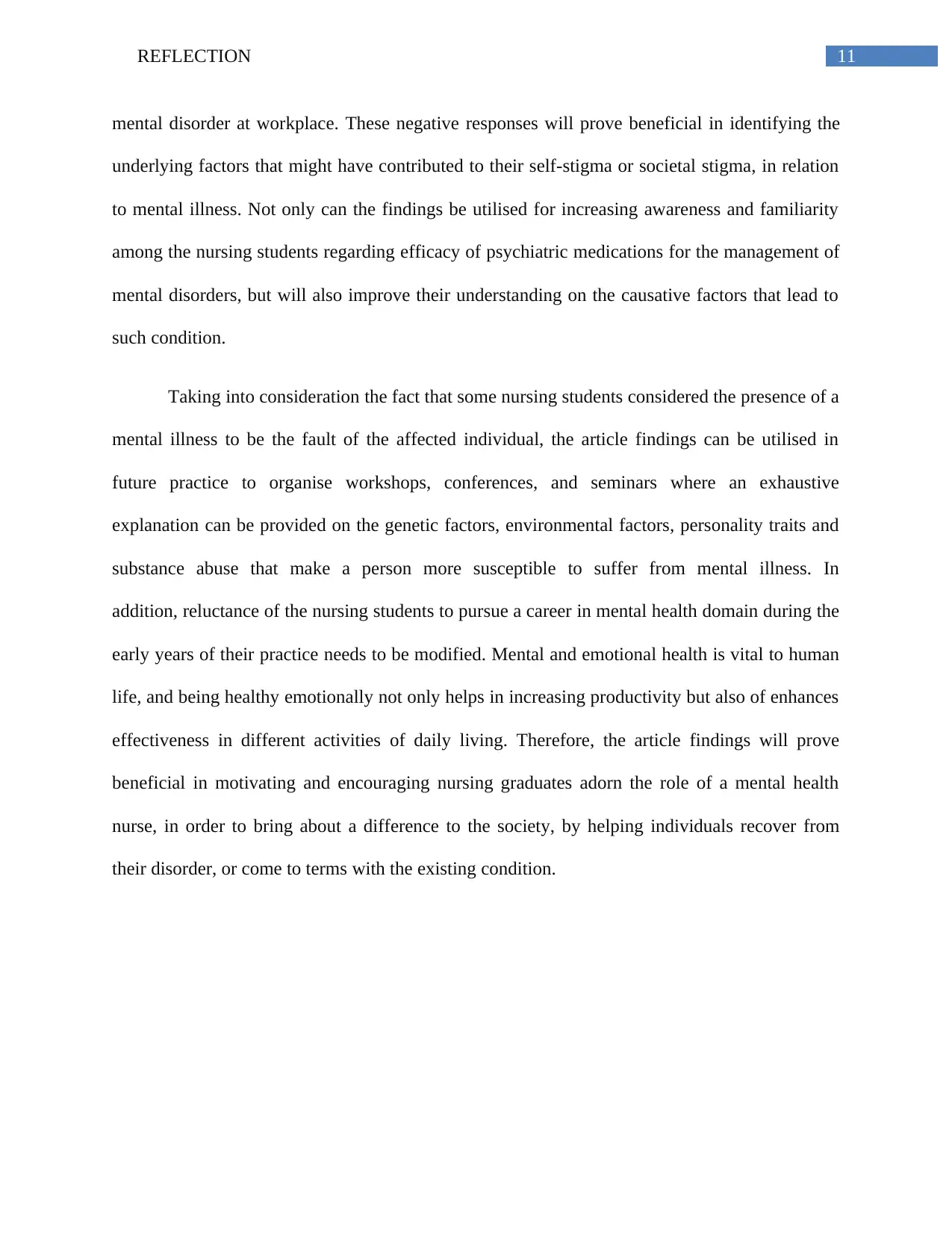
11REFLECTION
mental disorder at workplace. These negative responses will prove beneficial in identifying the
underlying factors that might have contributed to their self-stigma or societal stigma, in relation
to mental illness. Not only can the findings be utilised for increasing awareness and familiarity
among the nursing students regarding efficacy of psychiatric medications for the management of
mental disorders, but will also improve their understanding on the causative factors that lead to
such condition.
Taking into consideration the fact that some nursing students considered the presence of a
mental illness to be the fault of the affected individual, the article findings can be utilised in
future practice to organise workshops, conferences, and seminars where an exhaustive
explanation can be provided on the genetic factors, environmental factors, personality traits and
substance abuse that make a person more susceptible to suffer from mental illness. In
addition, reluctance of the nursing students to pursue a career in mental health domain during the
early years of their practice needs to be modified. Mental and emotional health is vital to human
life, and being healthy emotionally not only helps in increasing productivity but also of enhances
effectiveness in different activities of daily living. Therefore, the article findings will prove
beneficial in motivating and encouraging nursing graduates adorn the role of a mental health
nurse, in order to bring about a difference to the society, by helping individuals recover from
their disorder, or come to terms with the existing condition.
mental disorder at workplace. These negative responses will prove beneficial in identifying the
underlying factors that might have contributed to their self-stigma or societal stigma, in relation
to mental illness. Not only can the findings be utilised for increasing awareness and familiarity
among the nursing students regarding efficacy of psychiatric medications for the management of
mental disorders, but will also improve their understanding on the causative factors that lead to
such condition.
Taking into consideration the fact that some nursing students considered the presence of a
mental illness to be the fault of the affected individual, the article findings can be utilised in
future practice to organise workshops, conferences, and seminars where an exhaustive
explanation can be provided on the genetic factors, environmental factors, personality traits and
substance abuse that make a person more susceptible to suffer from mental illness. In
addition, reluctance of the nursing students to pursue a career in mental health domain during the
early years of their practice needs to be modified. Mental and emotional health is vital to human
life, and being healthy emotionally not only helps in increasing productivity but also of enhances
effectiveness in different activities of daily living. Therefore, the article findings will prove
beneficial in motivating and encouraging nursing graduates adorn the role of a mental health
nurse, in order to bring about a difference to the society, by helping individuals recover from
their disorder, or come to terms with the existing condition.
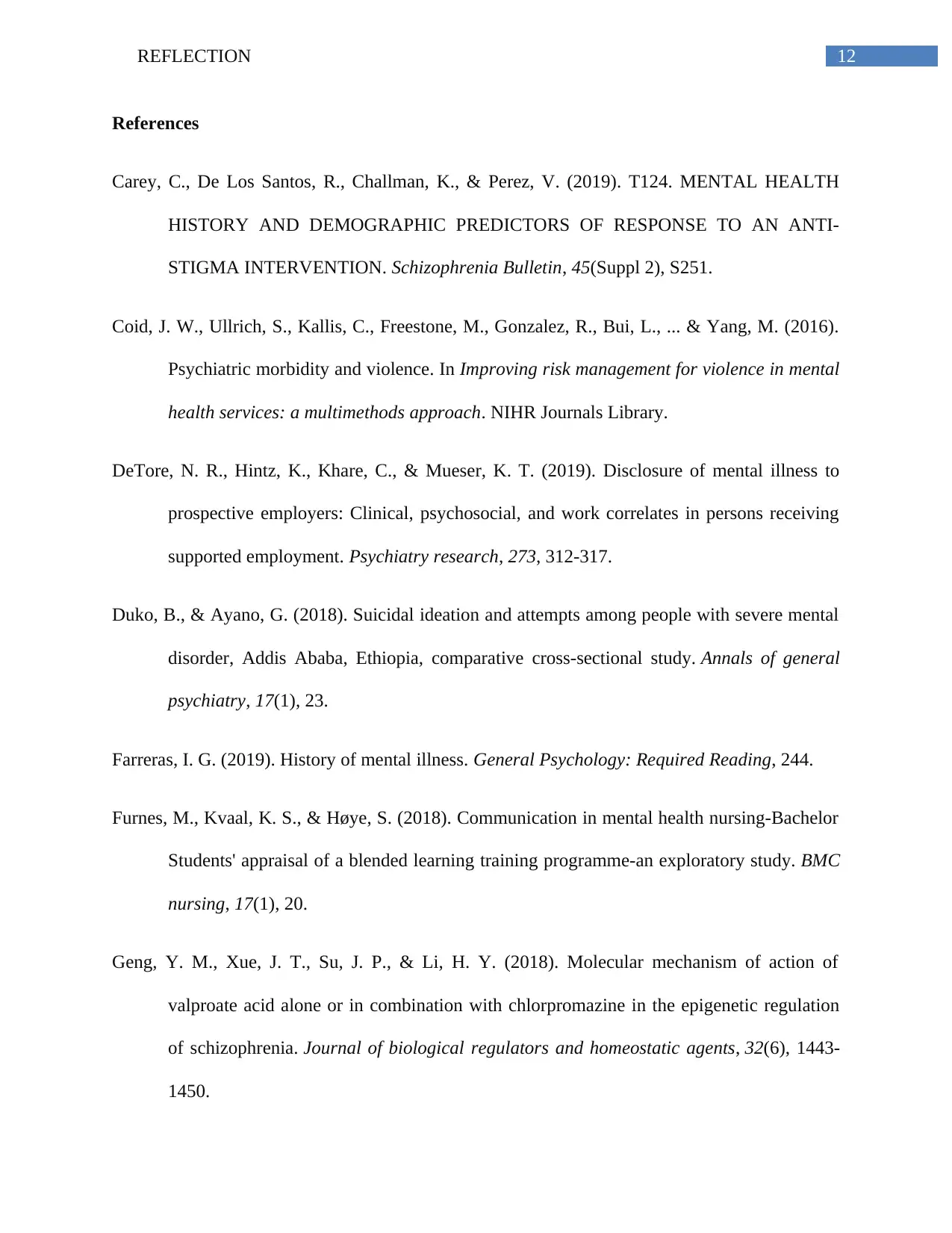
12REFLECTION
References
Carey, C., De Los Santos, R., Challman, K., & Perez, V. (2019). T124. MENTAL HEALTH
HISTORY AND DEMOGRAPHIC PREDICTORS OF RESPONSE TO AN ANTI-
STIGMA INTERVENTION. Schizophrenia Bulletin, 45(Suppl 2), S251.
Coid, J. W., Ullrich, S., Kallis, C., Freestone, M., Gonzalez, R., Bui, L., ... & Yang, M. (2016).
Psychiatric morbidity and violence. In Improving risk management for violence in mental
health services: a multimethods approach. NIHR Journals Library.
DeTore, N. R., Hintz, K., Khare, C., & Mueser, K. T. (2019). Disclosure of mental illness to
prospective employers: Clinical, psychosocial, and work correlates in persons receiving
supported employment. Psychiatry research, 273, 312-317.
Duko, B., & Ayano, G. (2018). Suicidal ideation and attempts among people with severe mental
disorder, Addis Ababa, Ethiopia, comparative cross-sectional study. Annals of general
psychiatry, 17(1), 23.
Farreras, I. G. (2019). History of mental illness. General Psychology: Required Reading, 244.
Furnes, M., Kvaal, K. S., & Høye, S. (2018). Communication in mental health nursing-Bachelor
Students' appraisal of a blended learning training programme-an exploratory study. BMC
nursing, 17(1), 20.
Geng, Y. M., Xue, J. T., Su, J. P., & Li, H. Y. (2018). Molecular mechanism of action of
valproate acid alone or in combination with chlorpromazine in the epigenetic regulation
of schizophrenia. Journal of biological regulators and homeostatic agents, 32(6), 1443-
1450.
References
Carey, C., De Los Santos, R., Challman, K., & Perez, V. (2019). T124. MENTAL HEALTH
HISTORY AND DEMOGRAPHIC PREDICTORS OF RESPONSE TO AN ANTI-
STIGMA INTERVENTION. Schizophrenia Bulletin, 45(Suppl 2), S251.
Coid, J. W., Ullrich, S., Kallis, C., Freestone, M., Gonzalez, R., Bui, L., ... & Yang, M. (2016).
Psychiatric morbidity and violence. In Improving risk management for violence in mental
health services: a multimethods approach. NIHR Journals Library.
DeTore, N. R., Hintz, K., Khare, C., & Mueser, K. T. (2019). Disclosure of mental illness to
prospective employers: Clinical, psychosocial, and work correlates in persons receiving
supported employment. Psychiatry research, 273, 312-317.
Duko, B., & Ayano, G. (2018). Suicidal ideation and attempts among people with severe mental
disorder, Addis Ababa, Ethiopia, comparative cross-sectional study. Annals of general
psychiatry, 17(1), 23.
Farreras, I. G. (2019). History of mental illness. General Psychology: Required Reading, 244.
Furnes, M., Kvaal, K. S., & Høye, S. (2018). Communication in mental health nursing-Bachelor
Students' appraisal of a blended learning training programme-an exploratory study. BMC
nursing, 17(1), 20.
Geng, Y. M., Xue, J. T., Su, J. P., & Li, H. Y. (2018). Molecular mechanism of action of
valproate acid alone or in combination with chlorpromazine in the epigenetic regulation
of schizophrenia. Journal of biological regulators and homeostatic agents, 32(6), 1443-
1450.
Paraphrase This Document
Need a fresh take? Get an instant paraphrase of this document with our AI Paraphraser
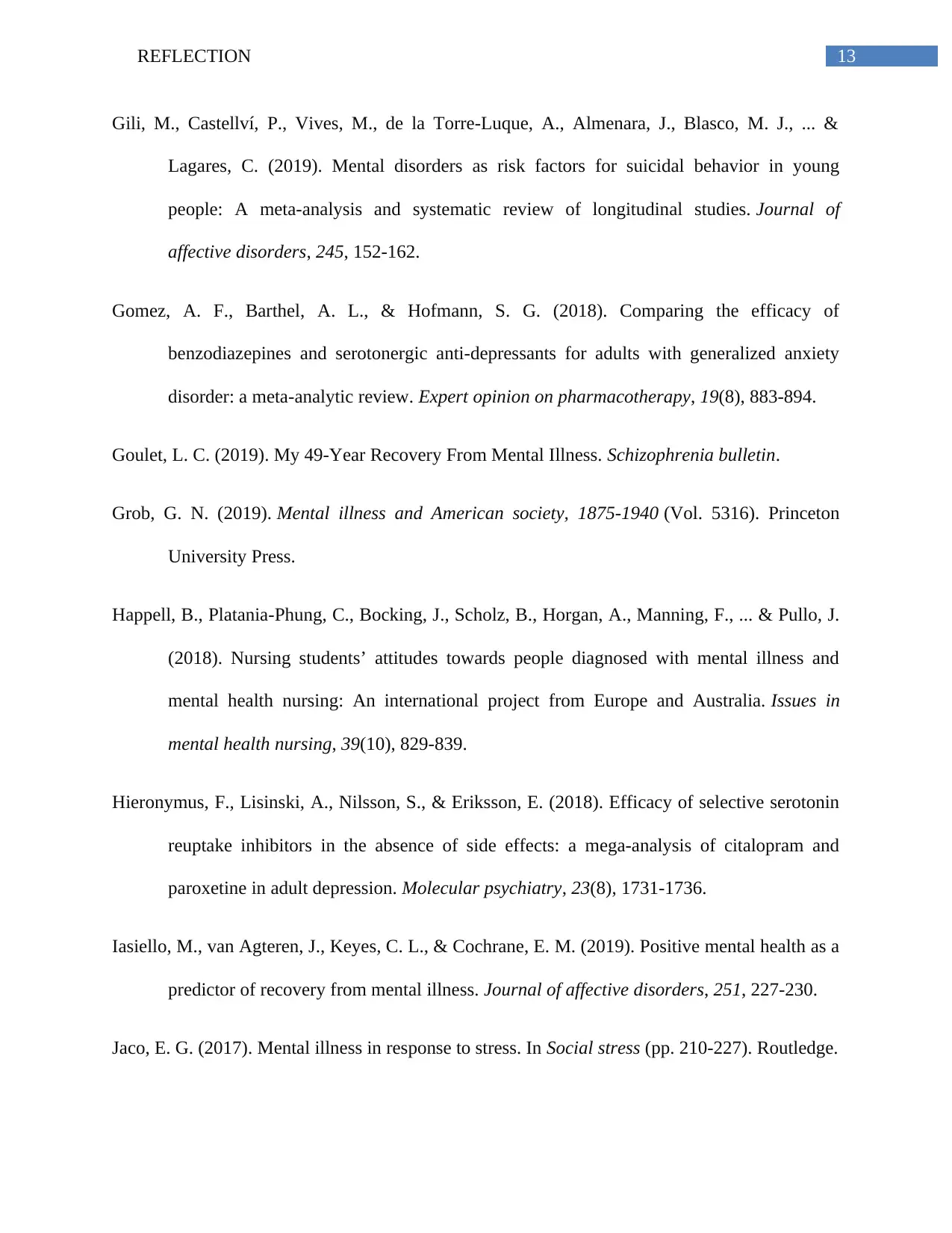
13REFLECTION
Gili, M., Castellví, P., Vives, M., de la Torre-Luque, A., Almenara, J., Blasco, M. J., ... &
Lagares, C. (2019). Mental disorders as risk factors for suicidal behavior in young
people: A meta-analysis and systematic review of longitudinal studies. Journal of
affective disorders, 245, 152-162.
Gomez, A. F., Barthel, A. L., & Hofmann, S. G. (2018). Comparing the efficacy of
benzodiazepines and serotonergic anti-depressants for adults with generalized anxiety
disorder: a meta-analytic review. Expert opinion on pharmacotherapy, 19(8), 883-894.
Goulet, L. C. (2019). My 49-Year Recovery From Mental Illness. Schizophrenia bulletin.
Grob, G. N. (2019). Mental illness and American society, 1875-1940 (Vol. 5316). Princeton
University Press.
Happell, B., Platania-Phung, C., Bocking, J., Scholz, B., Horgan, A., Manning, F., ... & Pullo, J.
(2018). Nursing students’ attitudes towards people diagnosed with mental illness and
mental health nursing: An international project from Europe and Australia. Issues in
mental health nursing, 39(10), 829-839.
Hieronymus, F., Lisinski, A., Nilsson, S., & Eriksson, E. (2018). Efficacy of selective serotonin
reuptake inhibitors in the absence of side effects: a mega-analysis of citalopram and
paroxetine in adult depression. Molecular psychiatry, 23(8), 1731-1736.
Iasiello, M., van Agteren, J., Keyes, C. L., & Cochrane, E. M. (2019). Positive mental health as a
predictor of recovery from mental illness. Journal of affective disorders, 251, 227-230.
Jaco, E. G. (2017). Mental illness in response to stress. In Social stress (pp. 210-227). Routledge.
Gili, M., Castellví, P., Vives, M., de la Torre-Luque, A., Almenara, J., Blasco, M. J., ... &
Lagares, C. (2019). Mental disorders as risk factors for suicidal behavior in young
people: A meta-analysis and systematic review of longitudinal studies. Journal of
affective disorders, 245, 152-162.
Gomez, A. F., Barthel, A. L., & Hofmann, S. G. (2018). Comparing the efficacy of
benzodiazepines and serotonergic anti-depressants for adults with generalized anxiety
disorder: a meta-analytic review. Expert opinion on pharmacotherapy, 19(8), 883-894.
Goulet, L. C. (2019). My 49-Year Recovery From Mental Illness. Schizophrenia bulletin.
Grob, G. N. (2019). Mental illness and American society, 1875-1940 (Vol. 5316). Princeton
University Press.
Happell, B., Platania-Phung, C., Bocking, J., Scholz, B., Horgan, A., Manning, F., ... & Pullo, J.
(2018). Nursing students’ attitudes towards people diagnosed with mental illness and
mental health nursing: An international project from Europe and Australia. Issues in
mental health nursing, 39(10), 829-839.
Hieronymus, F., Lisinski, A., Nilsson, S., & Eriksson, E. (2018). Efficacy of selective serotonin
reuptake inhibitors in the absence of side effects: a mega-analysis of citalopram and
paroxetine in adult depression. Molecular psychiatry, 23(8), 1731-1736.
Iasiello, M., van Agteren, J., Keyes, C. L., & Cochrane, E. M. (2019). Positive mental health as a
predictor of recovery from mental illness. Journal of affective disorders, 251, 227-230.
Jaco, E. G. (2017). Mental illness in response to stress. In Social stress (pp. 210-227). Routledge.
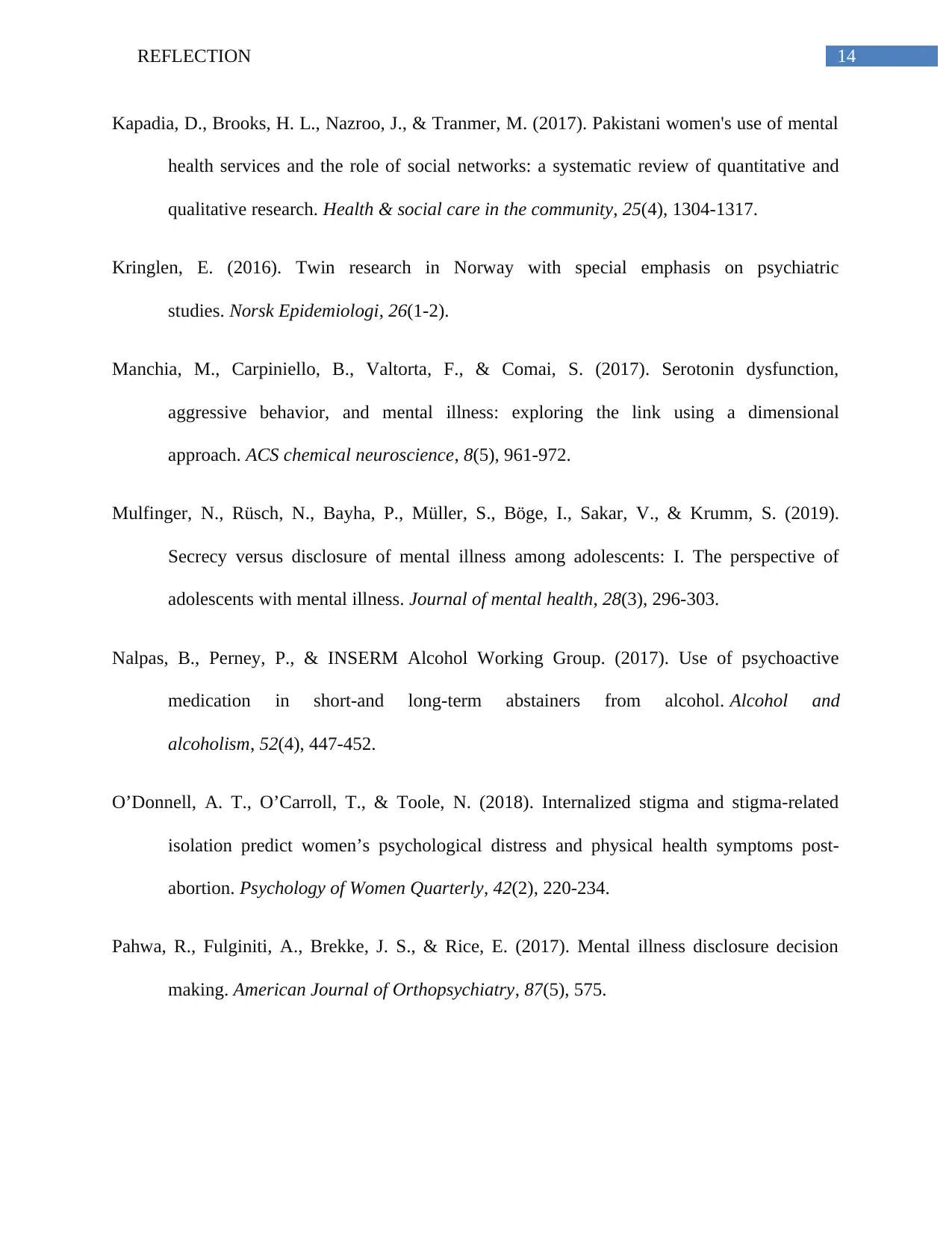
14REFLECTION
Kapadia, D., Brooks, H. L., Nazroo, J., & Tranmer, M. (2017). Pakistani women's use of mental
health services and the role of social networks: a systematic review of quantitative and
qualitative research. Health & social care in the community, 25(4), 1304-1317.
Kringlen, E. (2016). Twin research in Norway with special emphasis on psychiatric
studies. Norsk Epidemiologi, 26(1-2).
Manchia, M., Carpiniello, B., Valtorta, F., & Comai, S. (2017). Serotonin dysfunction,
aggressive behavior, and mental illness: exploring the link using a dimensional
approach. ACS chemical neuroscience, 8(5), 961-972.
Mulfinger, N., Rüsch, N., Bayha, P., Müller, S., Böge, I., Sakar, V., & Krumm, S. (2019).
Secrecy versus disclosure of mental illness among adolescents: I. The perspective of
adolescents with mental illness. Journal of mental health, 28(3), 296-303.
Nalpas, B., Perney, P., & INSERM Alcohol Working Group. (2017). Use of psychoactive
medication in short-and long-term abstainers from alcohol. Alcohol and
alcoholism, 52(4), 447-452.
O’Donnell, A. T., O’Carroll, T., & Toole, N. (2018). Internalized stigma and stigma-related
isolation predict women’s psychological distress and physical health symptoms post-
abortion. Psychology of Women Quarterly, 42(2), 220-234.
Pahwa, R., Fulginiti, A., Brekke, J. S., & Rice, E. (2017). Mental illness disclosure decision
making. American Journal of Orthopsychiatry, 87(5), 575.
Kapadia, D., Brooks, H. L., Nazroo, J., & Tranmer, M. (2017). Pakistani women's use of mental
health services and the role of social networks: a systematic review of quantitative and
qualitative research. Health & social care in the community, 25(4), 1304-1317.
Kringlen, E. (2016). Twin research in Norway with special emphasis on psychiatric
studies. Norsk Epidemiologi, 26(1-2).
Manchia, M., Carpiniello, B., Valtorta, F., & Comai, S. (2017). Serotonin dysfunction,
aggressive behavior, and mental illness: exploring the link using a dimensional
approach. ACS chemical neuroscience, 8(5), 961-972.
Mulfinger, N., Rüsch, N., Bayha, P., Müller, S., Böge, I., Sakar, V., & Krumm, S. (2019).
Secrecy versus disclosure of mental illness among adolescents: I. The perspective of
adolescents with mental illness. Journal of mental health, 28(3), 296-303.
Nalpas, B., Perney, P., & INSERM Alcohol Working Group. (2017). Use of psychoactive
medication in short-and long-term abstainers from alcohol. Alcohol and
alcoholism, 52(4), 447-452.
O’Donnell, A. T., O’Carroll, T., & Toole, N. (2018). Internalized stigma and stigma-related
isolation predict women’s psychological distress and physical health symptoms post-
abortion. Psychology of Women Quarterly, 42(2), 220-234.
Pahwa, R., Fulginiti, A., Brekke, J. S., & Rice, E. (2017). Mental illness disclosure decision
making. American Journal of Orthopsychiatry, 87(5), 575.
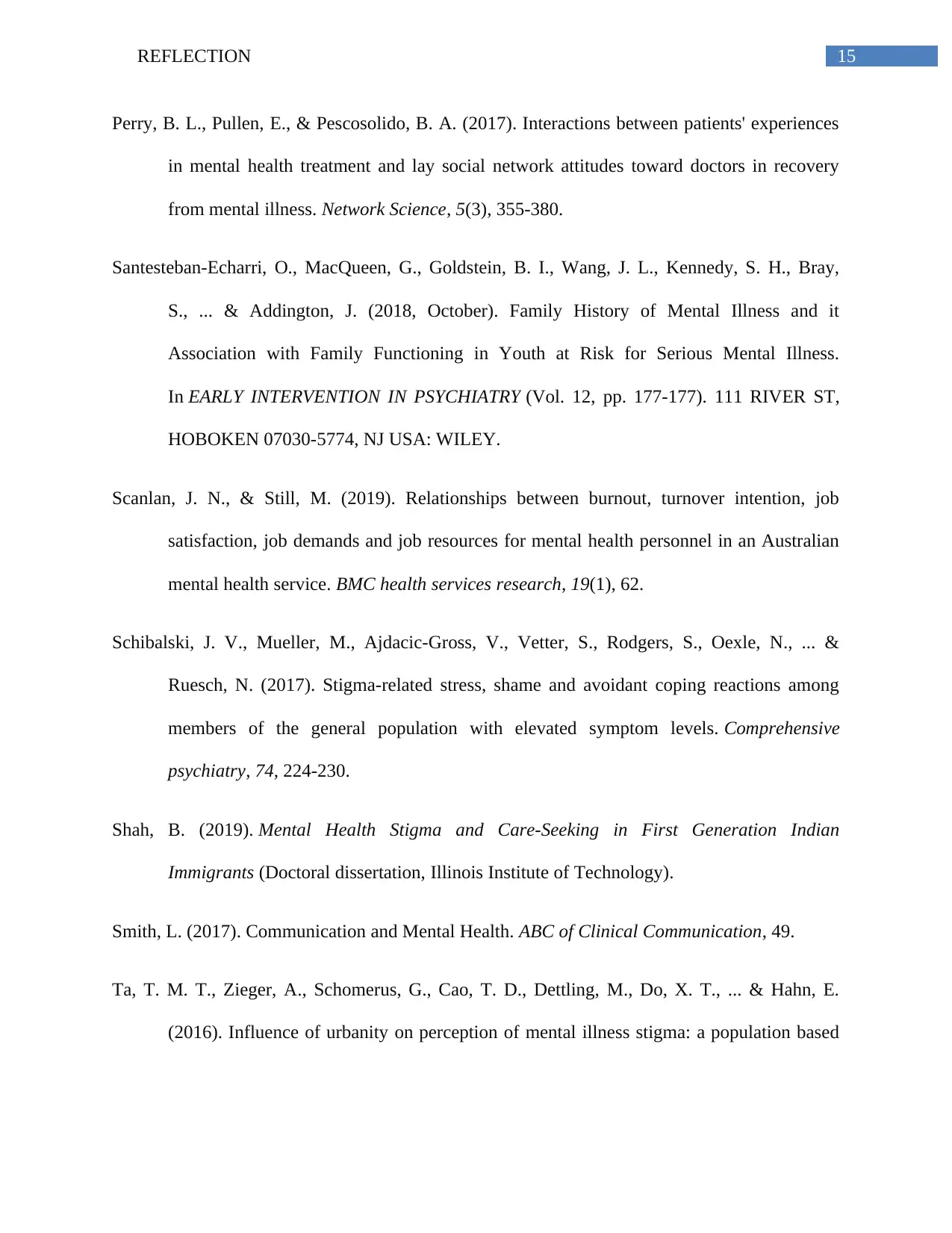
15REFLECTION
Perry, B. L., Pullen, E., & Pescosolido, B. A. (2017). Interactions between patients' experiences
in mental health treatment and lay social network attitudes toward doctors in recovery
from mental illness. Network Science, 5(3), 355-380.
Santesteban-Echarri, O., MacQueen, G., Goldstein, B. I., Wang, J. L., Kennedy, S. H., Bray,
S., ... & Addington, J. (2018, October). Family History of Mental Illness and it
Association with Family Functioning in Youth at Risk for Serious Mental Illness.
In EARLY INTERVENTION IN PSYCHIATRY (Vol. 12, pp. 177-177). 111 RIVER ST,
HOBOKEN 07030-5774, NJ USA: WILEY.
Scanlan, J. N., & Still, M. (2019). Relationships between burnout, turnover intention, job
satisfaction, job demands and job resources for mental health personnel in an Australian
mental health service. BMC health services research, 19(1), 62.
Schibalski, J. V., Mueller, M., Ajdacic-Gross, V., Vetter, S., Rodgers, S., Oexle, N., ... &
Ruesch, N. (2017). Stigma-related stress, shame and avoidant coping reactions among
members of the general population with elevated symptom levels. Comprehensive
psychiatry, 74, 224-230.
Shah, B. (2019). Mental Health Stigma and Care-Seeking in First Generation Indian
Immigrants (Doctoral dissertation, Illinois Institute of Technology).
Smith, L. (2017). Communication and Mental Health. ABC of Clinical Communication, 49.
Ta, T. M. T., Zieger, A., Schomerus, G., Cao, T. D., Dettling, M., Do, X. T., ... & Hahn, E.
(2016). Influence of urbanity on perception of mental illness stigma: a population based
Perry, B. L., Pullen, E., & Pescosolido, B. A. (2017). Interactions between patients' experiences
in mental health treatment and lay social network attitudes toward doctors in recovery
from mental illness. Network Science, 5(3), 355-380.
Santesteban-Echarri, O., MacQueen, G., Goldstein, B. I., Wang, J. L., Kennedy, S. H., Bray,
S., ... & Addington, J. (2018, October). Family History of Mental Illness and it
Association with Family Functioning in Youth at Risk for Serious Mental Illness.
In EARLY INTERVENTION IN PSYCHIATRY (Vol. 12, pp. 177-177). 111 RIVER ST,
HOBOKEN 07030-5774, NJ USA: WILEY.
Scanlan, J. N., & Still, M. (2019). Relationships between burnout, turnover intention, job
satisfaction, job demands and job resources for mental health personnel in an Australian
mental health service. BMC health services research, 19(1), 62.
Schibalski, J. V., Mueller, M., Ajdacic-Gross, V., Vetter, S., Rodgers, S., Oexle, N., ... &
Ruesch, N. (2017). Stigma-related stress, shame and avoidant coping reactions among
members of the general population with elevated symptom levels. Comprehensive
psychiatry, 74, 224-230.
Shah, B. (2019). Mental Health Stigma and Care-Seeking in First Generation Indian
Immigrants (Doctoral dissertation, Illinois Institute of Technology).
Smith, L. (2017). Communication and Mental Health. ABC of Clinical Communication, 49.
Ta, T. M. T., Zieger, A., Schomerus, G., Cao, T. D., Dettling, M., Do, X. T., ... & Hahn, E.
(2016). Influence of urbanity on perception of mental illness stigma: a population based
Secure Best Marks with AI Grader
Need help grading? Try our AI Grader for instant feedback on your assignments.
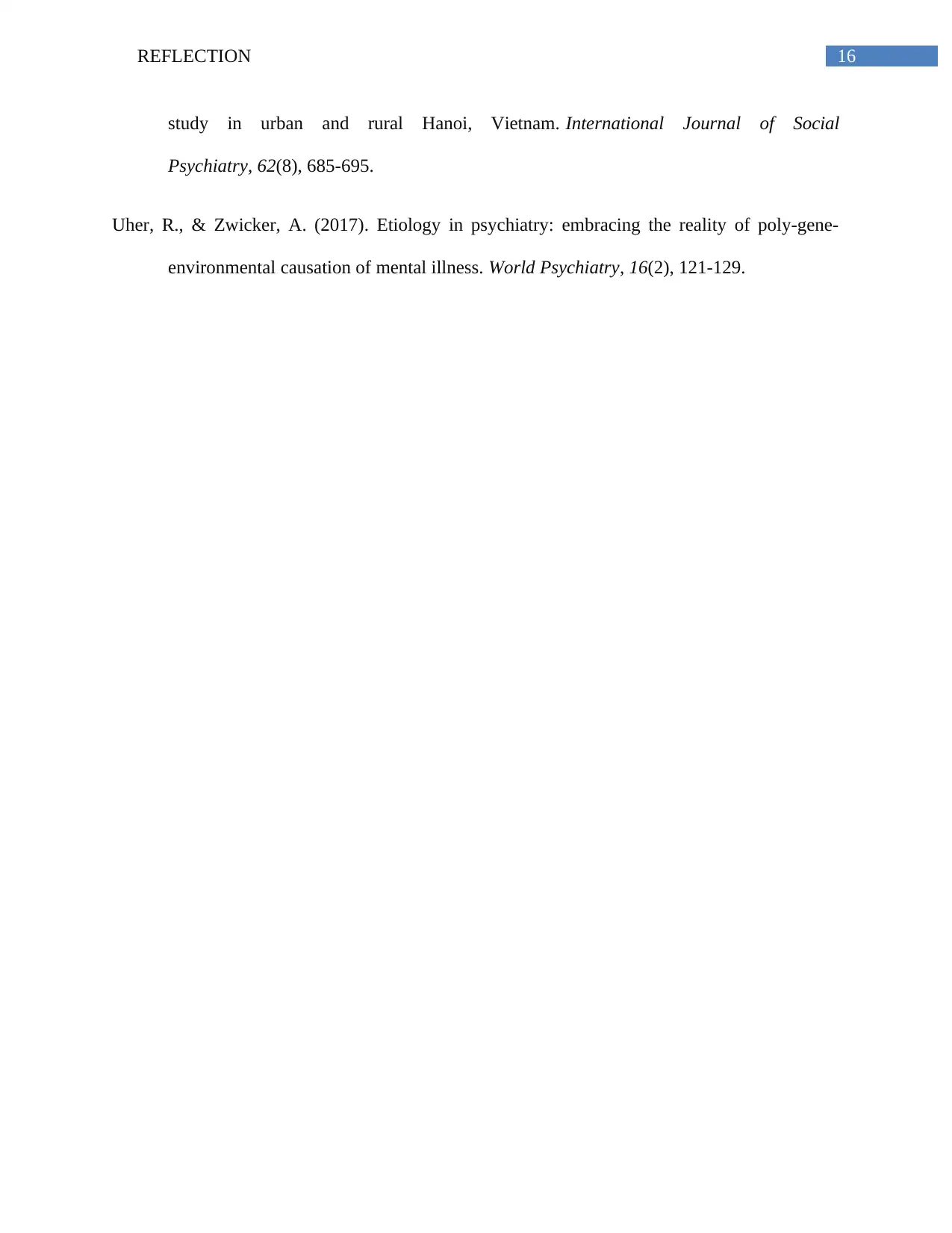
16REFLECTION
study in urban and rural Hanoi, Vietnam. International Journal of Social
Psychiatry, 62(8), 685-695.
Uher, R., & Zwicker, A. (2017). Etiology in psychiatry: embracing the reality of poly‐gene‐
environmental causation of mental illness. World Psychiatry, 16(2), 121-129.
study in urban and rural Hanoi, Vietnam. International Journal of Social
Psychiatry, 62(8), 685-695.
Uher, R., & Zwicker, A. (2017). Etiology in psychiatry: embracing the reality of poly‐gene‐
environmental causation of mental illness. World Psychiatry, 16(2), 121-129.
1 out of 17
Related Documents
Your All-in-One AI-Powered Toolkit for Academic Success.
+13062052269
info@desklib.com
Available 24*7 on WhatsApp / Email
![[object Object]](/_next/static/media/star-bottom.7253800d.svg)
Unlock your academic potential
© 2024 | Zucol Services PVT LTD | All rights reserved.





